The Mediating and Moderating Roles of Interdependent Self-Construal and Anger Suppression on Depression in an American Adult Sample
VerifiedAdded on 2023/06/04
|19
|5494
|472
AI Summary
This study examines the relationship between interdependent self-construal, anger suppression, and depression in American adults. The study aims to find significant predictors of depression in this adult sample. The results suggest that interdependent self-construal and anger suppression play a significant role in depression in middle-aged and older adults.
Contribute Materials
Your contribution can guide someone’s learning journey. Share your
documents today.
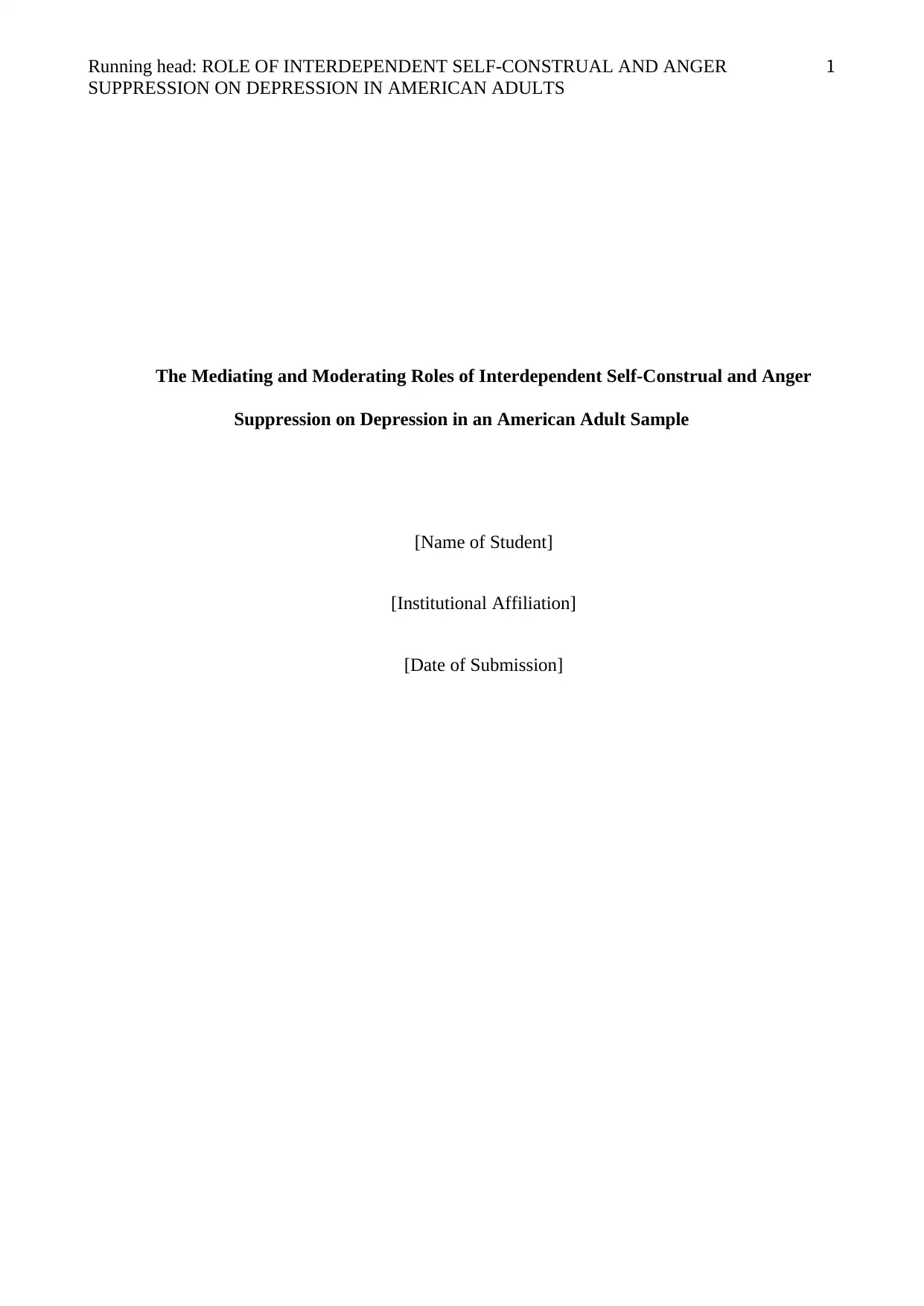
Running head: ROLE OF INTERDEPENDENT SELF-CONSTRUAL AND ANGER
SUPPRESSION ON DEPRESSION IN AMERICAN ADULTS
The Mediating and Moderating Roles of Interdependent Self-Construal and Anger
Suppression on Depression in an American Adult Sample
[Name of Student]
[Institutional Affiliation]
[Date of Submission]
1
SUPPRESSION ON DEPRESSION IN AMERICAN ADULTS
The Mediating and Moderating Roles of Interdependent Self-Construal and Anger
Suppression on Depression in an American Adult Sample
[Name of Student]
[Institutional Affiliation]
[Date of Submission]
1
Secure Best Marks with AI Grader
Need help grading? Try our AI Grader for instant feedback on your assignments.
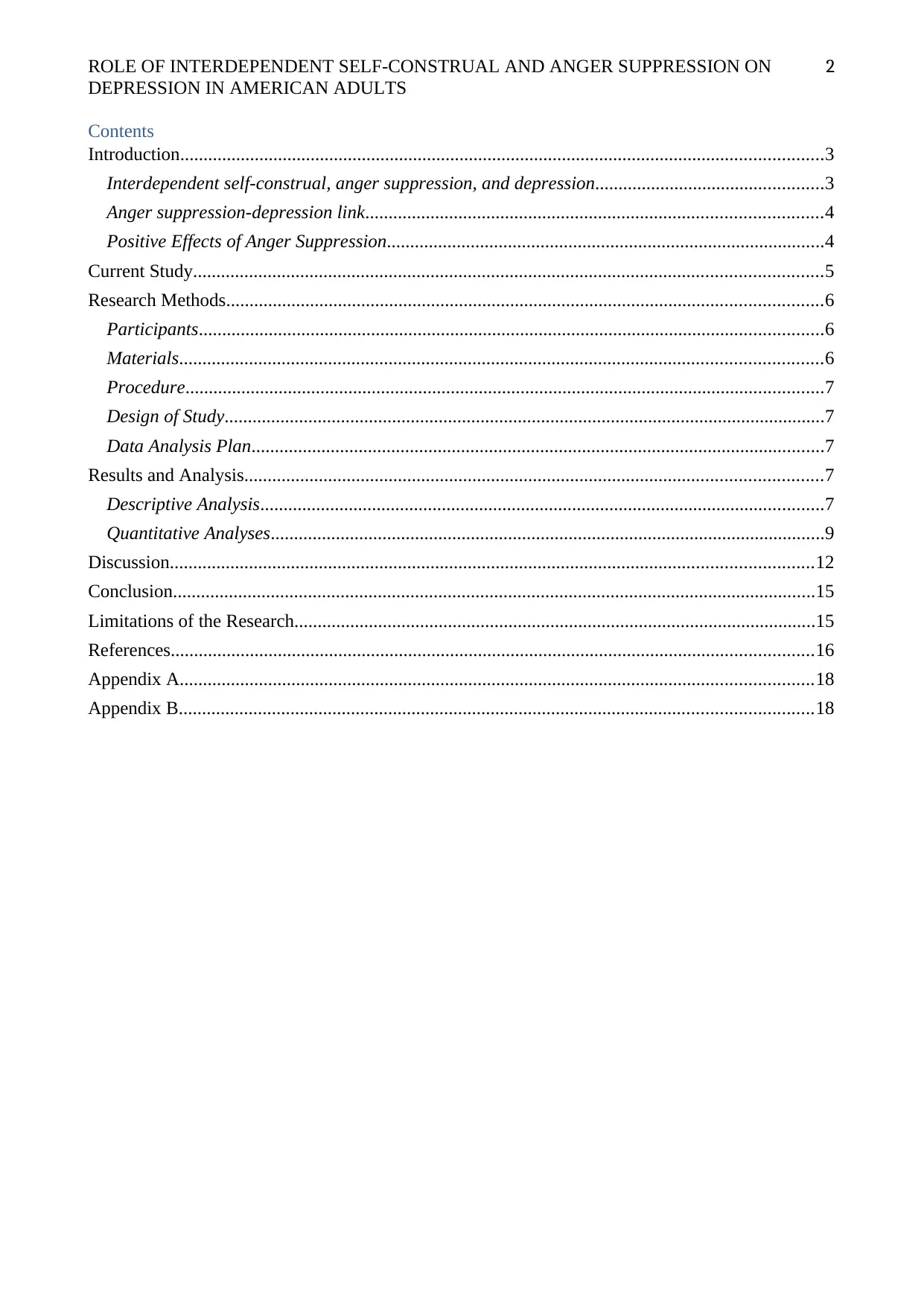
ROLE OF INTERDEPENDENT SELF-CONSTRUAL AND ANGER SUPPRESSION ON
DEPRESSION IN AMERICAN ADULTS
Contents
Introduction..........................................................................................................................................3
Interdependent self-construal, anger suppression, and depression.................................................3
Anger suppression-depression link..................................................................................................4
Positive Effects of Anger Suppression..............................................................................................4
Current Study.......................................................................................................................................5
Research Methods................................................................................................................................6
Participants......................................................................................................................................6
Materials..........................................................................................................................................6
Procedure.........................................................................................................................................7
Design of Study.................................................................................................................................7
Data Analysis Plan...........................................................................................................................7
Results and Analysis............................................................................................................................7
Descriptive Analysis.........................................................................................................................7
Quantitative Analyses.......................................................................................................................9
Discussion..........................................................................................................................................12
Conclusion..........................................................................................................................................15
Limitations of the Research................................................................................................................15
References..........................................................................................................................................16
Appendix A........................................................................................................................................18
Appendix B........................................................................................................................................18
2
DEPRESSION IN AMERICAN ADULTS
Contents
Introduction..........................................................................................................................................3
Interdependent self-construal, anger suppression, and depression.................................................3
Anger suppression-depression link..................................................................................................4
Positive Effects of Anger Suppression..............................................................................................4
Current Study.......................................................................................................................................5
Research Methods................................................................................................................................6
Participants......................................................................................................................................6
Materials..........................................................................................................................................6
Procedure.........................................................................................................................................7
Design of Study.................................................................................................................................7
Data Analysis Plan...........................................................................................................................7
Results and Analysis............................................................................................................................7
Descriptive Analysis.........................................................................................................................7
Quantitative Analyses.......................................................................................................................9
Discussion..........................................................................................................................................12
Conclusion..........................................................................................................................................15
Limitations of the Research................................................................................................................15
References..........................................................................................................................................16
Appendix A........................................................................................................................................18
Appendix B........................................................................................................................................18
2
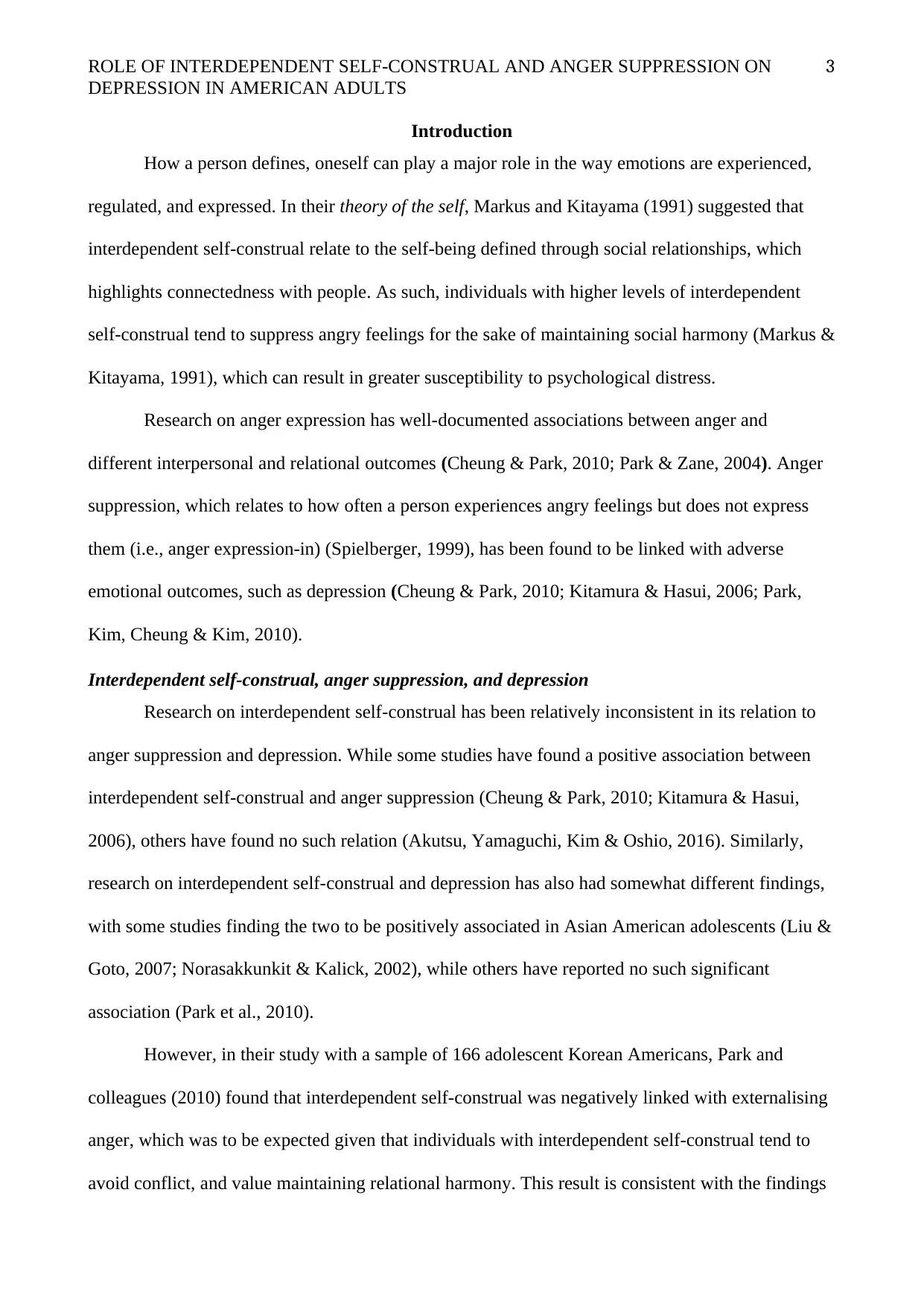
ROLE OF INTERDEPENDENT SELF-CONSTRUAL AND ANGER SUPPRESSION ON
DEPRESSION IN AMERICAN ADULTS
Introduction
How a person defines, oneself can play a major role in the way emotions are experienced,
regulated, and expressed. In their theory of the self, Markus and Kitayama (1991) suggested that
interdependent self-construal relate to the self-being defined through social relationships, which
highlights connectedness with people. As such, individuals with higher levels of interdependent
self-construal tend to suppress angry feelings for the sake of maintaining social harmony (Markus &
Kitayama, 1991), which can result in greater susceptibility to psychological distress.
Research on anger expression has well-documented associations between anger and
different interpersonal and relational outcomes (Cheung & Park, 2010; Park & Zane, 2004). Anger
suppression, which relates to how often a person experiences angry feelings but does not express
them (i.e., anger expression-in) (Spielberger, 1999), has been found to be linked with adverse
emotional outcomes, such as depression (Cheung & Park, 2010; Kitamura & Hasui, 2006; Park,
Kim, Cheung & Kim, 2010).
Interdependent self-construal, anger suppression, and depression
Research on interdependent self-construal has been relatively inconsistent in its relation to
anger suppression and depression. While some studies have found a positive association between
interdependent self-construal and anger suppression (Cheung & Park, 2010; Kitamura & Hasui,
2006), others have found no such relation (Akutsu, Yamaguchi, Kim & Oshio, 2016). Similarly,
research on interdependent self-construal and depression has also had somewhat different findings,
with some studies finding the two to be positively associated in Asian American adolescents (Liu &
Goto, 2007; Norasakkunkit & Kalick, 2002), while others have reported no such significant
association (Park et al., 2010).
However, in their study with a sample of 166 adolescent Korean Americans, Park and
colleagues (2010) found that interdependent self-construal was negatively linked with externalising
anger, which was to be expected given that individuals with interdependent self-construal tend to
avoid conflict, and value maintaining relational harmony. This result is consistent with the findings
3
DEPRESSION IN AMERICAN ADULTS
Introduction
How a person defines, oneself can play a major role in the way emotions are experienced,
regulated, and expressed. In their theory of the self, Markus and Kitayama (1991) suggested that
interdependent self-construal relate to the self-being defined through social relationships, which
highlights connectedness with people. As such, individuals with higher levels of interdependent
self-construal tend to suppress angry feelings for the sake of maintaining social harmony (Markus &
Kitayama, 1991), which can result in greater susceptibility to psychological distress.
Research on anger expression has well-documented associations between anger and
different interpersonal and relational outcomes (Cheung & Park, 2010; Park & Zane, 2004). Anger
suppression, which relates to how often a person experiences angry feelings but does not express
them (i.e., anger expression-in) (Spielberger, 1999), has been found to be linked with adverse
emotional outcomes, such as depression (Cheung & Park, 2010; Kitamura & Hasui, 2006; Park,
Kim, Cheung & Kim, 2010).
Interdependent self-construal, anger suppression, and depression
Research on interdependent self-construal has been relatively inconsistent in its relation to
anger suppression and depression. While some studies have found a positive association between
interdependent self-construal and anger suppression (Cheung & Park, 2010; Kitamura & Hasui,
2006), others have found no such relation (Akutsu, Yamaguchi, Kim & Oshio, 2016). Similarly,
research on interdependent self-construal and depression has also had somewhat different findings,
with some studies finding the two to be positively associated in Asian American adolescents (Liu &
Goto, 2007; Norasakkunkit & Kalick, 2002), while others have reported no such significant
association (Park et al., 2010).
However, in their study with a sample of 166 adolescent Korean Americans, Park and
colleagues (2010) found that interdependent self-construal was negatively linked with externalising
anger, which was to be expected given that individuals with interdependent self-construal tend to
avoid conflict, and value maintaining relational harmony. This result is consistent with the findings
3
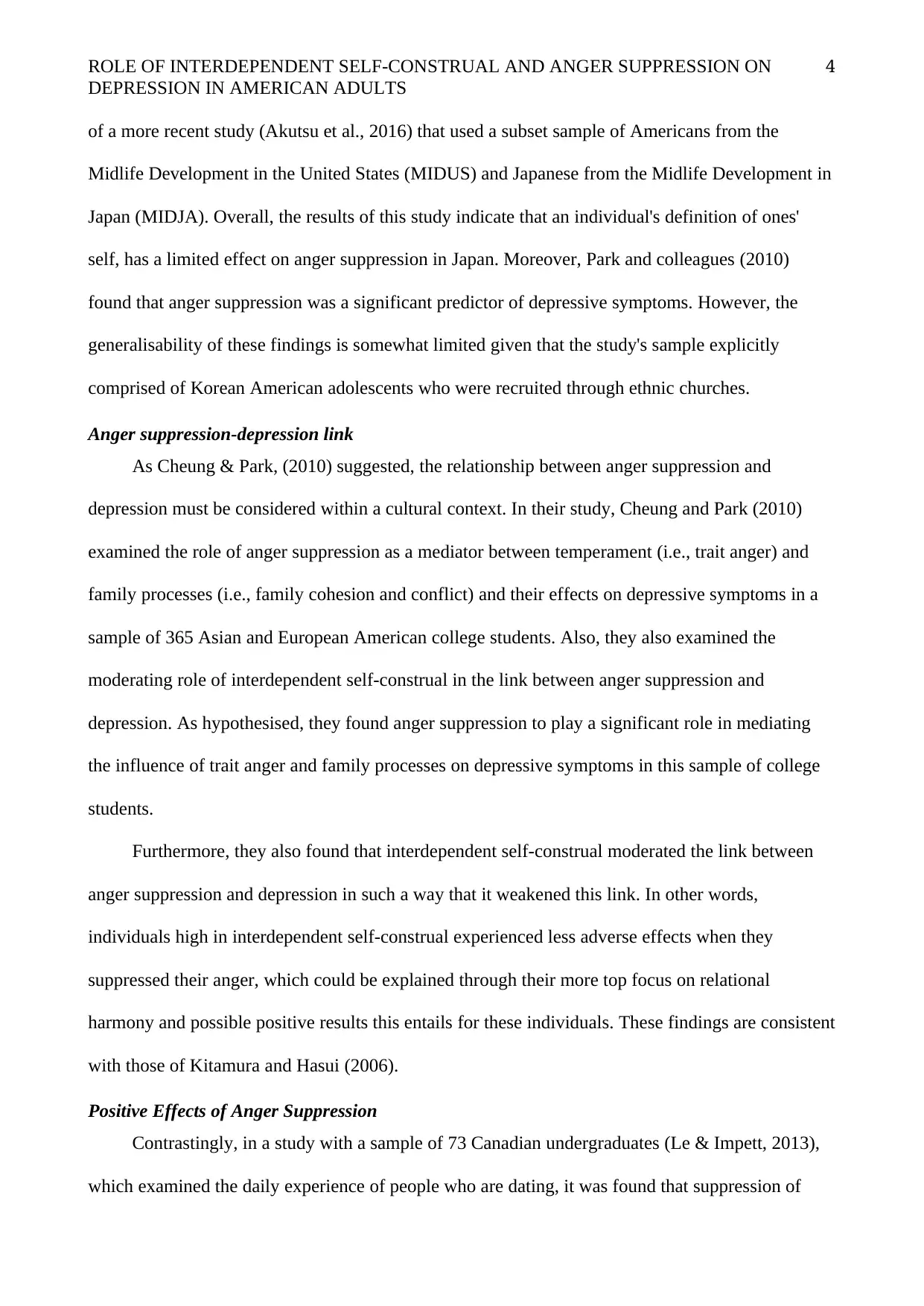
ROLE OF INTERDEPENDENT SELF-CONSTRUAL AND ANGER SUPPRESSION ON
DEPRESSION IN AMERICAN ADULTS
of a more recent study (Akutsu et al., 2016) that used a subset sample of Americans from the
Midlife Development in the United States (MIDUS) and Japanese from the Midlife Development in
Japan (MIDJA). Overall, the results of this study indicate that an individual's definition of ones'
self, has a limited effect on anger suppression in Japan. Moreover, Park and colleagues (2010)
found that anger suppression was a significant predictor of depressive symptoms. However, the
generalisability of these findings is somewhat limited given that the study's sample explicitly
comprised of Korean American adolescents who were recruited through ethnic churches.
Anger suppression-depression link
As Cheung & Park, (2010) suggested, the relationship between anger suppression and
depression must be considered within a cultural context. In their study, Cheung and Park (2010)
examined the role of anger suppression as a mediator between temperament (i.e., trait anger) and
family processes (i.e., family cohesion and conflict) and their effects on depressive symptoms in a
sample of 365 Asian and European American college students. Also, they also examined the
moderating role of interdependent self-construal in the link between anger suppression and
depression. As hypothesised, they found anger suppression to play a significant role in mediating
the influence of trait anger and family processes on depressive symptoms in this sample of college
students.
Furthermore, they also found that interdependent self-construal moderated the link between
anger suppression and depression in such a way that it weakened this link. In other words,
individuals high in interdependent self-construal experienced less adverse effects when they
suppressed their anger, which could be explained through their more top focus on relational
harmony and possible positive results this entails for these individuals. These findings are consistent
with those of Kitamura and Hasui (2006).
Positive Effects of Anger Suppression
Contrastingly, in a study with a sample of 73 Canadian undergraduates (Le & Impett, 2013),
which examined the daily experience of people who are dating, it was found that suppression of
4
DEPRESSION IN AMERICAN ADULTS
of a more recent study (Akutsu et al., 2016) that used a subset sample of Americans from the
Midlife Development in the United States (MIDUS) and Japanese from the Midlife Development in
Japan (MIDJA). Overall, the results of this study indicate that an individual's definition of ones'
self, has a limited effect on anger suppression in Japan. Moreover, Park and colleagues (2010)
found that anger suppression was a significant predictor of depressive symptoms. However, the
generalisability of these findings is somewhat limited given that the study's sample explicitly
comprised of Korean American adolescents who were recruited through ethnic churches.
Anger suppression-depression link
As Cheung & Park, (2010) suggested, the relationship between anger suppression and
depression must be considered within a cultural context. In their study, Cheung and Park (2010)
examined the role of anger suppression as a mediator between temperament (i.e., trait anger) and
family processes (i.e., family cohesion and conflict) and their effects on depressive symptoms in a
sample of 365 Asian and European American college students. Also, they also examined the
moderating role of interdependent self-construal in the link between anger suppression and
depression. As hypothesised, they found anger suppression to play a significant role in mediating
the influence of trait anger and family processes on depressive symptoms in this sample of college
students.
Furthermore, they also found that interdependent self-construal moderated the link between
anger suppression and depression in such a way that it weakened this link. In other words,
individuals high in interdependent self-construal experienced less adverse effects when they
suppressed their anger, which could be explained through their more top focus on relational
harmony and possible positive results this entails for these individuals. These findings are consistent
with those of Kitamura and Hasui (2006).
Positive Effects of Anger Suppression
Contrastingly, in a study with a sample of 73 Canadian undergraduates (Le & Impett, 2013),
which examined the daily experience of people who are dating, it was found that suppression of
4
Secure Best Marks with AI Grader
Need help grading? Try our AI Grader for instant feedback on your assignments.
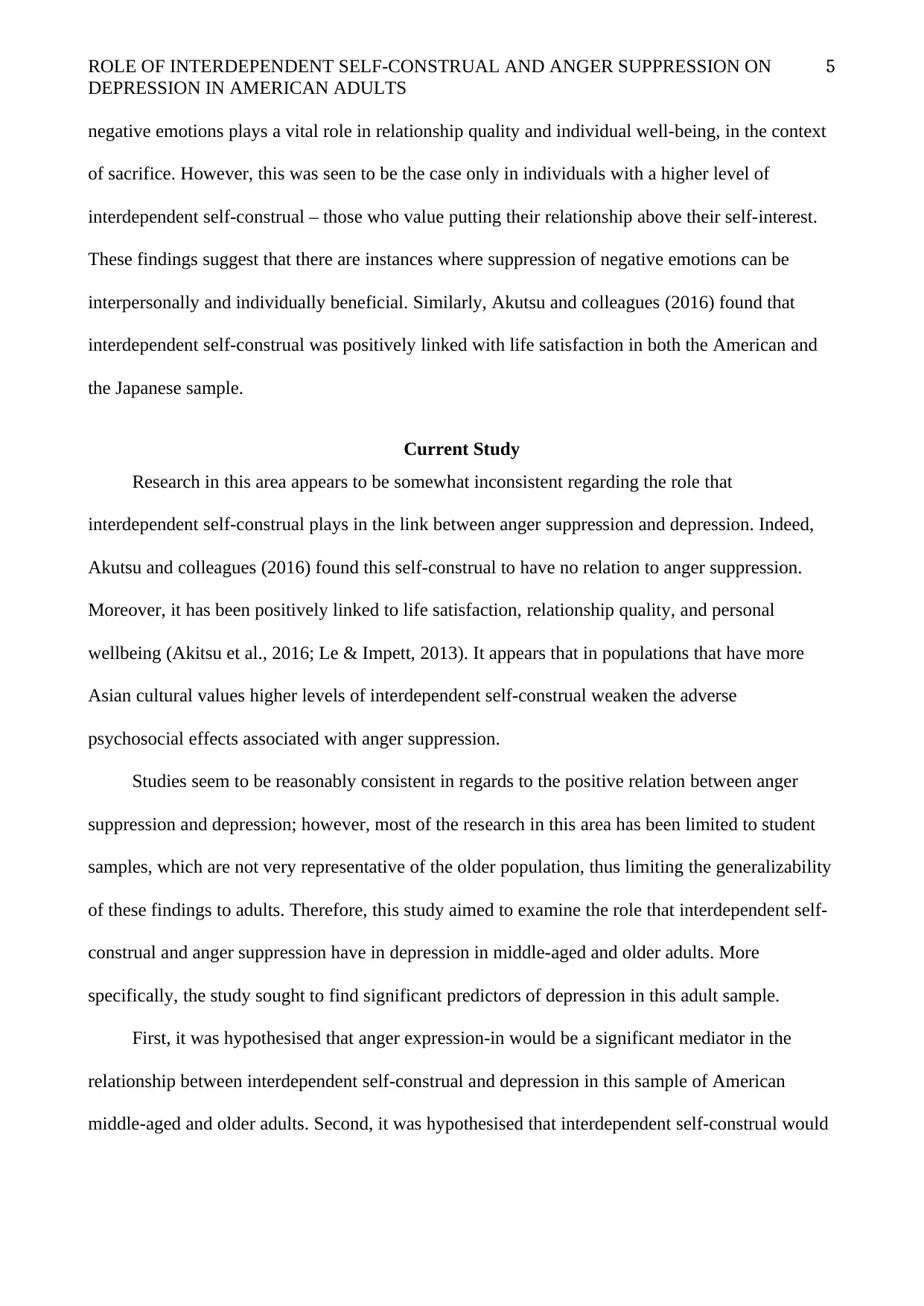
ROLE OF INTERDEPENDENT SELF-CONSTRUAL AND ANGER SUPPRESSION ON
DEPRESSION IN AMERICAN ADULTS
negative emotions plays a vital role in relationship quality and individual well-being, in the context
of sacrifice. However, this was seen to be the case only in individuals with a higher level of
interdependent self-construal – those who value putting their relationship above their self-interest.
These findings suggest that there are instances where suppression of negative emotions can be
interpersonally and individually beneficial. Similarly, Akutsu and colleagues (2016) found that
interdependent self-construal was positively linked with life satisfaction in both the American and
the Japanese sample.
Current Study
Research in this area appears to be somewhat inconsistent regarding the role that
interdependent self-construal plays in the link between anger suppression and depression. Indeed,
Akutsu and colleagues (2016) found this self-construal to have no relation to anger suppression.
Moreover, it has been positively linked to life satisfaction, relationship quality, and personal
wellbeing (Akitsu et al., 2016; Le & Impett, 2013). It appears that in populations that have more
Asian cultural values higher levels of interdependent self-construal weaken the adverse
psychosocial effects associated with anger suppression.
Studies seem to be reasonably consistent in regards to the positive relation between anger
suppression and depression; however, most of the research in this area has been limited to student
samples, which are not very representative of the older population, thus limiting the generalizability
of these findings to adults. Therefore, this study aimed to examine the role that interdependent self-
construal and anger suppression have in depression in middle-aged and older adults. More
specifically, the study sought to find significant predictors of depression in this adult sample.
First, it was hypothesised that anger expression-in would be a significant mediator in the
relationship between interdependent self-construal and depression in this sample of American
middle-aged and older adults. Second, it was hypothesised that interdependent self-construal would
5
DEPRESSION IN AMERICAN ADULTS
negative emotions plays a vital role in relationship quality and individual well-being, in the context
of sacrifice. However, this was seen to be the case only in individuals with a higher level of
interdependent self-construal – those who value putting their relationship above their self-interest.
These findings suggest that there are instances where suppression of negative emotions can be
interpersonally and individually beneficial. Similarly, Akutsu and colleagues (2016) found that
interdependent self-construal was positively linked with life satisfaction in both the American and
the Japanese sample.
Current Study
Research in this area appears to be somewhat inconsistent regarding the role that
interdependent self-construal plays in the link between anger suppression and depression. Indeed,
Akutsu and colleagues (2016) found this self-construal to have no relation to anger suppression.
Moreover, it has been positively linked to life satisfaction, relationship quality, and personal
wellbeing (Akitsu et al., 2016; Le & Impett, 2013). It appears that in populations that have more
Asian cultural values higher levels of interdependent self-construal weaken the adverse
psychosocial effects associated with anger suppression.
Studies seem to be reasonably consistent in regards to the positive relation between anger
suppression and depression; however, most of the research in this area has been limited to student
samples, which are not very representative of the older population, thus limiting the generalizability
of these findings to adults. Therefore, this study aimed to examine the role that interdependent self-
construal and anger suppression have in depression in middle-aged and older adults. More
specifically, the study sought to find significant predictors of depression in this adult sample.
First, it was hypothesised that anger expression-in would be a significant mediator in the
relationship between interdependent self-construal and depression in this sample of American
middle-aged and older adults. Second, it was hypothesised that interdependent self-construal would
5
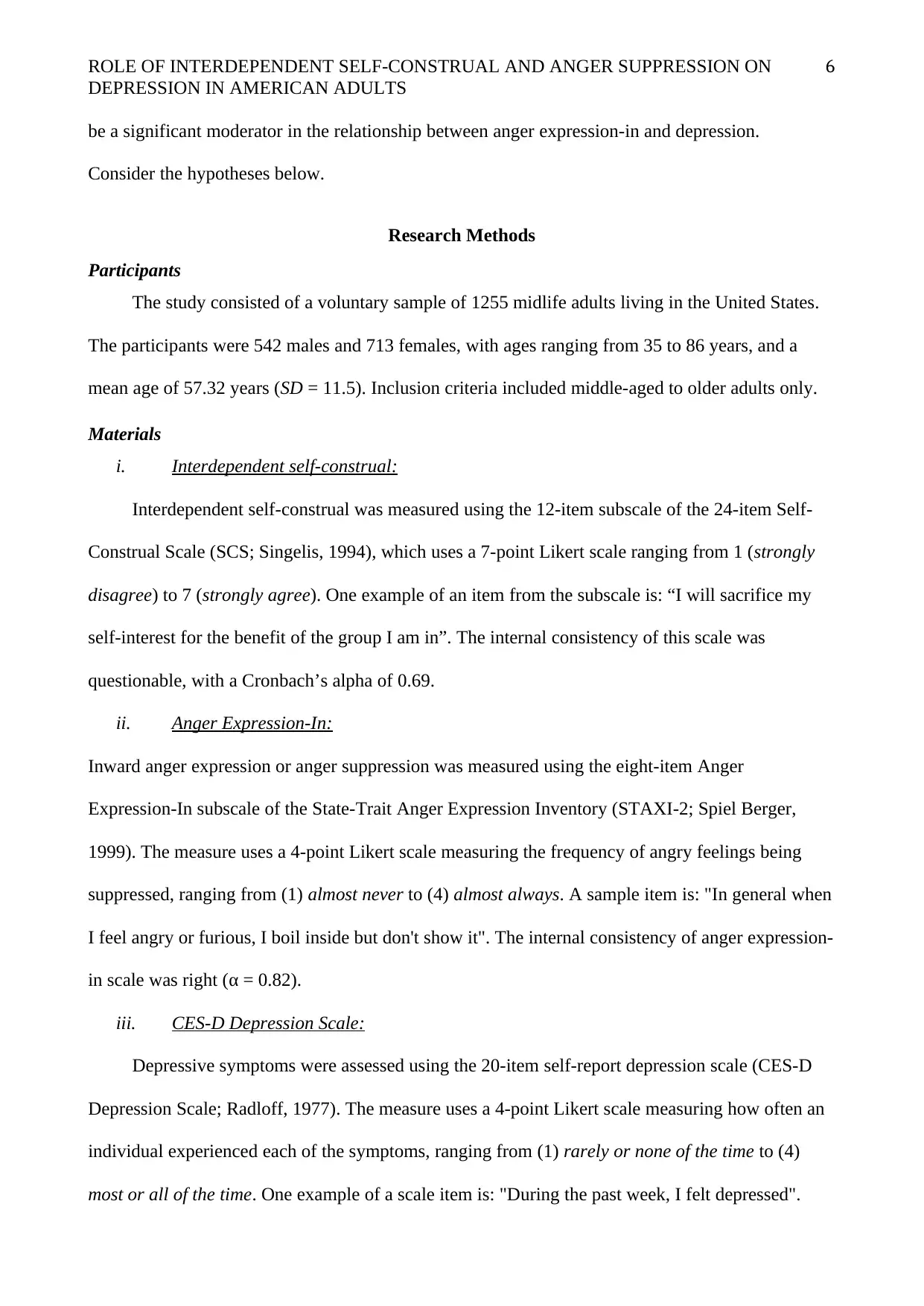
ROLE OF INTERDEPENDENT SELF-CONSTRUAL AND ANGER SUPPRESSION ON
DEPRESSION IN AMERICAN ADULTS
be a significant moderator in the relationship between anger expression-in and depression.
Consider the hypotheses below.
Research Methods
Participants
The study consisted of a voluntary sample of 1255 midlife adults living in the United States.
The participants were 542 males and 713 females, with ages ranging from 35 to 86 years, and a
mean age of 57.32 years (SD = 11.5). Inclusion criteria included middle-aged to older adults only.
Materials
i. Interdependent self-construal:
Interdependent self-construal was measured using the 12-item subscale of the 24-item Self-
Construal Scale (SCS; Singelis, 1994), which uses a 7-point Likert scale ranging from 1 (strongly
disagree) to 7 (strongly agree). One example of an item from the subscale is: “I will sacrifice my
self-interest for the benefit of the group I am in”. The internal consistency of this scale was
questionable, with a Cronbach’s alpha of 0.69.
ii. Anger Expression-In:
Inward anger expression or anger suppression was measured using the eight-item Anger
Expression-In subscale of the State-Trait Anger Expression Inventory (STAXI-2; Spiel Berger,
1999). The measure uses a 4-point Likert scale measuring the frequency of angry feelings being
suppressed, ranging from (1) almost never to (4) almost always. A sample item is: "In general when
I feel angry or furious, I boil inside but don't show it". The internal consistency of anger expression-
in scale was right (α = 0.82).
iii. CES-D Depression Scale:
Depressive symptoms were assessed using the 20-item self-report depression scale (CES-D
Depression Scale; Radloff, 1977). The measure uses a 4-point Likert scale measuring how often an
individual experienced each of the symptoms, ranging from (1) rarely or none of the time to (4)
most or all of the time. One example of a scale item is: "During the past week, I felt depressed".
6
DEPRESSION IN AMERICAN ADULTS
be a significant moderator in the relationship between anger expression-in and depression.
Consider the hypotheses below.
Research Methods
Participants
The study consisted of a voluntary sample of 1255 midlife adults living in the United States.
The participants were 542 males and 713 females, with ages ranging from 35 to 86 years, and a
mean age of 57.32 years (SD = 11.5). Inclusion criteria included middle-aged to older adults only.
Materials
i. Interdependent self-construal:
Interdependent self-construal was measured using the 12-item subscale of the 24-item Self-
Construal Scale (SCS; Singelis, 1994), which uses a 7-point Likert scale ranging from 1 (strongly
disagree) to 7 (strongly agree). One example of an item from the subscale is: “I will sacrifice my
self-interest for the benefit of the group I am in”. The internal consistency of this scale was
questionable, with a Cronbach’s alpha of 0.69.
ii. Anger Expression-In:
Inward anger expression or anger suppression was measured using the eight-item Anger
Expression-In subscale of the State-Trait Anger Expression Inventory (STAXI-2; Spiel Berger,
1999). The measure uses a 4-point Likert scale measuring the frequency of angry feelings being
suppressed, ranging from (1) almost never to (4) almost always. A sample item is: "In general when
I feel angry or furious, I boil inside but don't show it". The internal consistency of anger expression-
in scale was right (α = 0.82).
iii. CES-D Depression Scale:
Depressive symptoms were assessed using the 20-item self-report depression scale (CES-D
Depression Scale; Radloff, 1977). The measure uses a 4-point Likert scale measuring how often an
individual experienced each of the symptoms, ranging from (1) rarely or none of the time to (4)
most or all of the time. One example of a scale item is: "During the past week, I felt depressed".
6
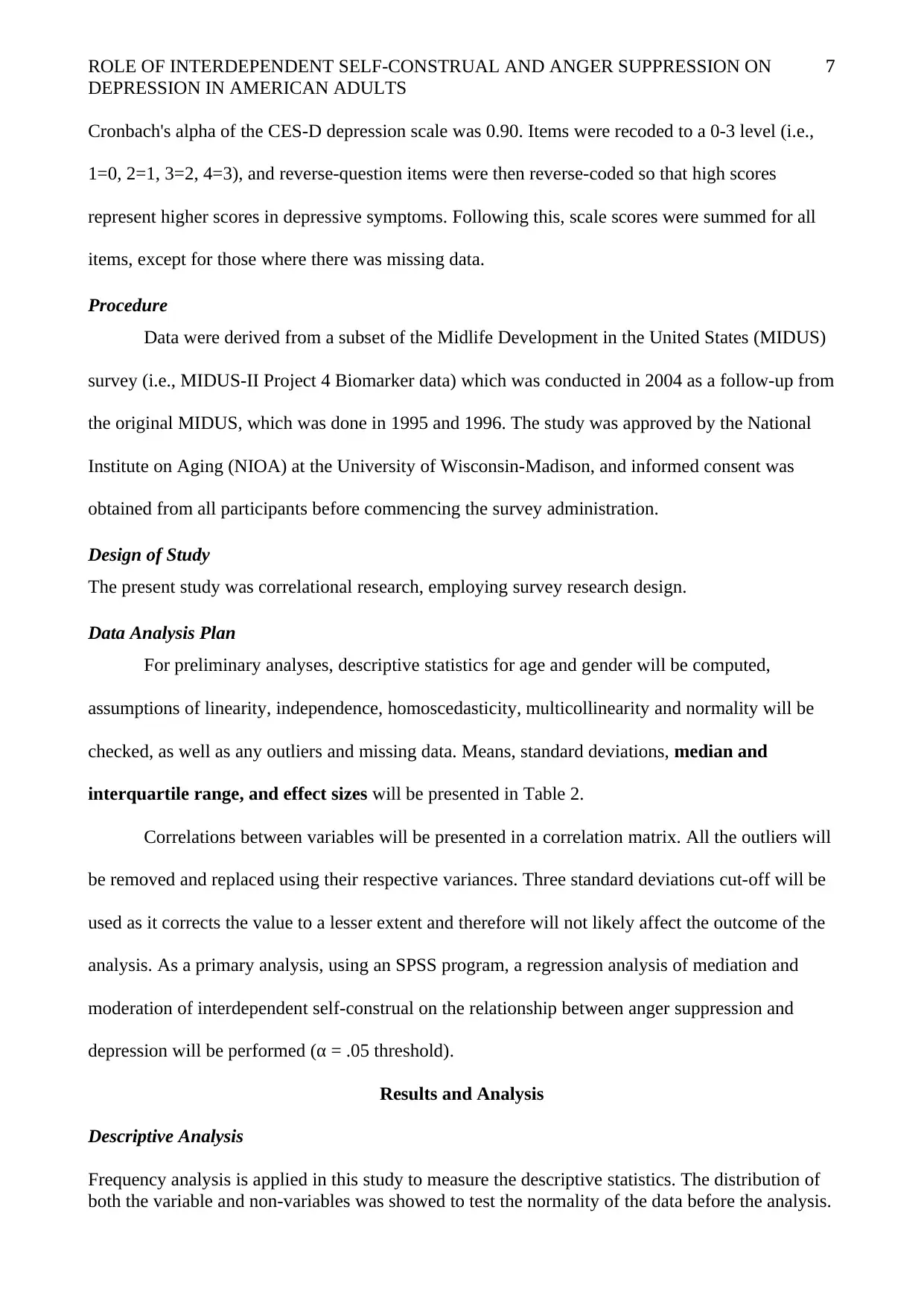
ROLE OF INTERDEPENDENT SELF-CONSTRUAL AND ANGER SUPPRESSION ON
DEPRESSION IN AMERICAN ADULTS
Cronbach's alpha of the CES-D depression scale was 0.90. Items were recoded to a 0-3 level (i.e.,
1=0, 2=1, 3=2, 4=3), and reverse-question items were then reverse-coded so that high scores
represent higher scores in depressive symptoms. Following this, scale scores were summed for all
items, except for those where there was missing data.
Procedure
Data were derived from a subset of the Midlife Development in the United States (MIDUS)
survey (i.e., MIDUS-II Project 4 Biomarker data) which was conducted in 2004 as a follow-up from
the original MIDUS, which was done in 1995 and 1996. The study was approved by the National
Institute on Aging (NIOA) at the University of Wisconsin-Madison, and informed consent was
obtained from all participants before commencing the survey administration.
Design of Study
The present study was correlational research, employing survey research design.
Data Analysis Plan
For preliminary analyses, descriptive statistics for age and gender will be computed,
assumptions of linearity, independence, homoscedasticity, multicollinearity and normality will be
checked, as well as any outliers and missing data. Means, standard deviations, median and
interquartile range, and effect sizes will be presented in Table 2.
Correlations between variables will be presented in a correlation matrix. All the outliers will
be removed and replaced using their respective variances. Three standard deviations cut-off will be
used as it corrects the value to a lesser extent and therefore will not likely affect the outcome of the
analysis. As a primary analysis, using an SPSS program, a regression analysis of mediation and
moderation of interdependent self-construal on the relationship between anger suppression and
depression will be performed (α = .05 threshold).
Results and Analysis
Descriptive Analysis
Frequency analysis is applied in this study to measure the descriptive statistics. The distribution of
both the variable and non-variables was showed to test the normality of the data before the analysis.
7
DEPRESSION IN AMERICAN ADULTS
Cronbach's alpha of the CES-D depression scale was 0.90. Items were recoded to a 0-3 level (i.e.,
1=0, 2=1, 3=2, 4=3), and reverse-question items were then reverse-coded so that high scores
represent higher scores in depressive symptoms. Following this, scale scores were summed for all
items, except for those where there was missing data.
Procedure
Data were derived from a subset of the Midlife Development in the United States (MIDUS)
survey (i.e., MIDUS-II Project 4 Biomarker data) which was conducted in 2004 as a follow-up from
the original MIDUS, which was done in 1995 and 1996. The study was approved by the National
Institute on Aging (NIOA) at the University of Wisconsin-Madison, and informed consent was
obtained from all participants before commencing the survey administration.
Design of Study
The present study was correlational research, employing survey research design.
Data Analysis Plan
For preliminary analyses, descriptive statistics for age and gender will be computed,
assumptions of linearity, independence, homoscedasticity, multicollinearity and normality will be
checked, as well as any outliers and missing data. Means, standard deviations, median and
interquartile range, and effect sizes will be presented in Table 2.
Correlations between variables will be presented in a correlation matrix. All the outliers will
be removed and replaced using their respective variances. Three standard deviations cut-off will be
used as it corrects the value to a lesser extent and therefore will not likely affect the outcome of the
analysis. As a primary analysis, using an SPSS program, a regression analysis of mediation and
moderation of interdependent self-construal on the relationship between anger suppression and
depression will be performed (α = .05 threshold).
Results and Analysis
Descriptive Analysis
Frequency analysis is applied in this study to measure the descriptive statistics. The distribution of
both the variable and non-variables was showed to test the normality of the data before the analysis.
7
Paraphrase This Document
Need a fresh take? Get an instant paraphrase of this document with our AI Paraphraser
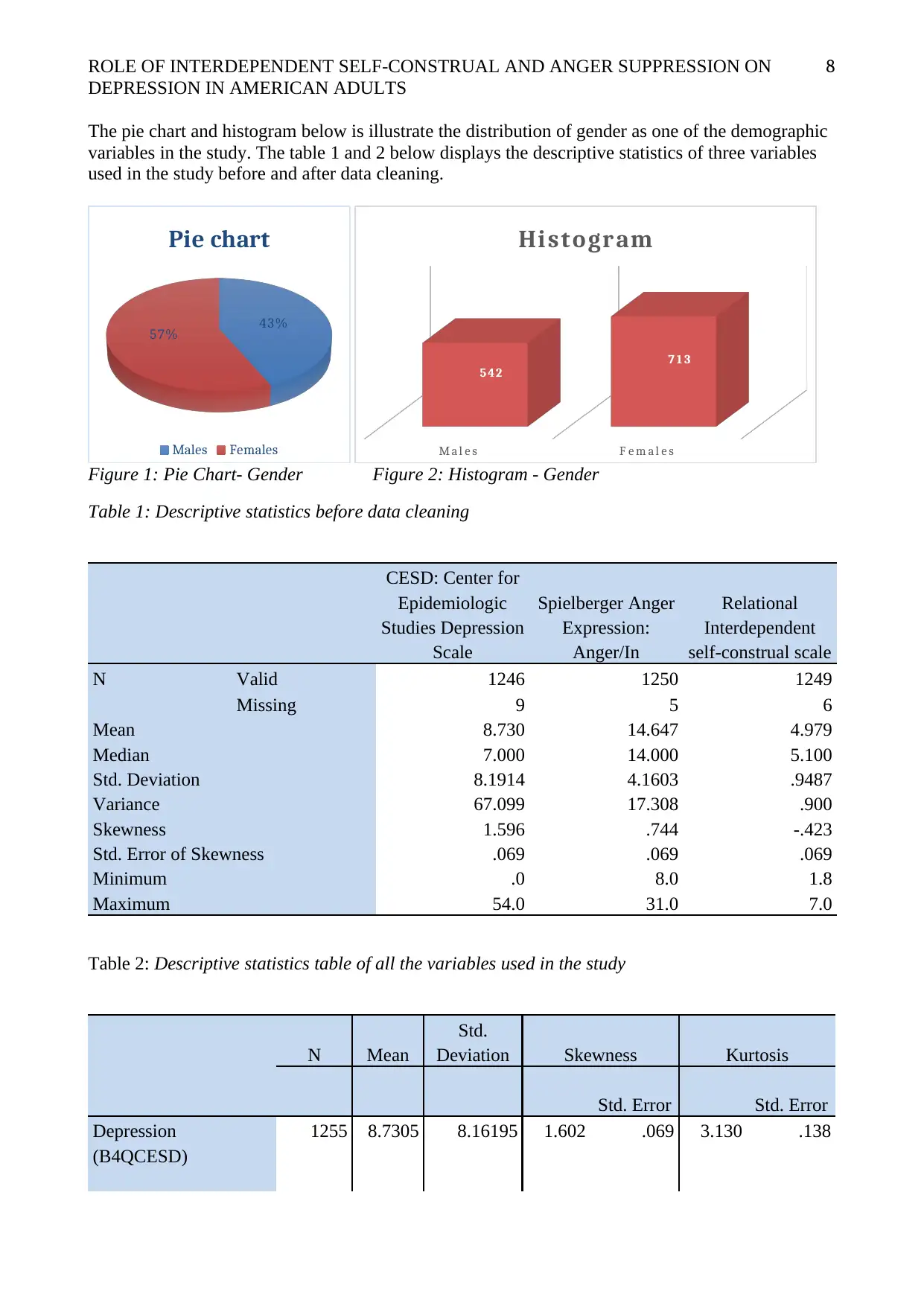
ROLE OF INTERDEPENDENT SELF-CONSTRUAL AND ANGER SUPPRESSION ON
DEPRESSION IN AMERICAN ADULTS
The pie chart and histogram below is illustrate the distribution of gender as one of the demographic
variables in the study. The table 1 and 2 below displays the descriptive statistics of three variables
used in the study before and after data cleaning.
43%
57%
Pie chart
Males Females M a l e s F e m a l e s
542
713
Histogram
Figure 1: Pie Chart- Gender Figure 2: Histogram - Gender
Table 1: Descriptive statistics before data cleaning
CESD: Center for
Epidemiologic
Studies Depression
Scale
Spielberger Anger
Expression:
Anger/In
Relational
Interdependent
self-construal scale
N Valid 1246 1250 1249
Missing 9 5 6
Mean 8.730 14.647 4.979
Median 7.000 14.000 5.100
Std. Deviation 8.1914 4.1603 .9487
Variance 67.099 17.308 .900
Skewness 1.596 .744 -.423
Std. Error of Skewness .069 .069 .069
Minimum .0 8.0 1.8
Maximum 54.0 31.0 7.0
Table 2: Descriptive statistics table of all the variables used in the study
N Mean
Std.
Deviation Skewness Kurtosis
Std. Error Std. Error
Depression
(B4QCESD)
1255 8.7305 8.16195 1.602 .069 3.130 .138
8
DEPRESSION IN AMERICAN ADULTS
The pie chart and histogram below is illustrate the distribution of gender as one of the demographic
variables in the study. The table 1 and 2 below displays the descriptive statistics of three variables
used in the study before and after data cleaning.
43%
57%
Pie chart
Males Females M a l e s F e m a l e s
542
713
Histogram
Figure 1: Pie Chart- Gender Figure 2: Histogram - Gender
Table 1: Descriptive statistics before data cleaning
CESD: Center for
Epidemiologic
Studies Depression
Scale
Spielberger Anger
Expression:
Anger/In
Relational
Interdependent
self-construal scale
N Valid 1246 1250 1249
Missing 9 5 6
Mean 8.730 14.647 4.979
Median 7.000 14.000 5.100
Std. Deviation 8.1914 4.1603 .9487
Variance 67.099 17.308 .900
Skewness 1.596 .744 -.423
Std. Error of Skewness .069 .069 .069
Minimum .0 8.0 1.8
Maximum 54.0 31.0 7.0
Table 2: Descriptive statistics table of all the variables used in the study
N Mean
Std.
Deviation Skewness Kurtosis
Std. Error Std. Error
Depression
(B4QCESD)
1255 8.7305 8.16195 1.602 .069 3.130 .138
8
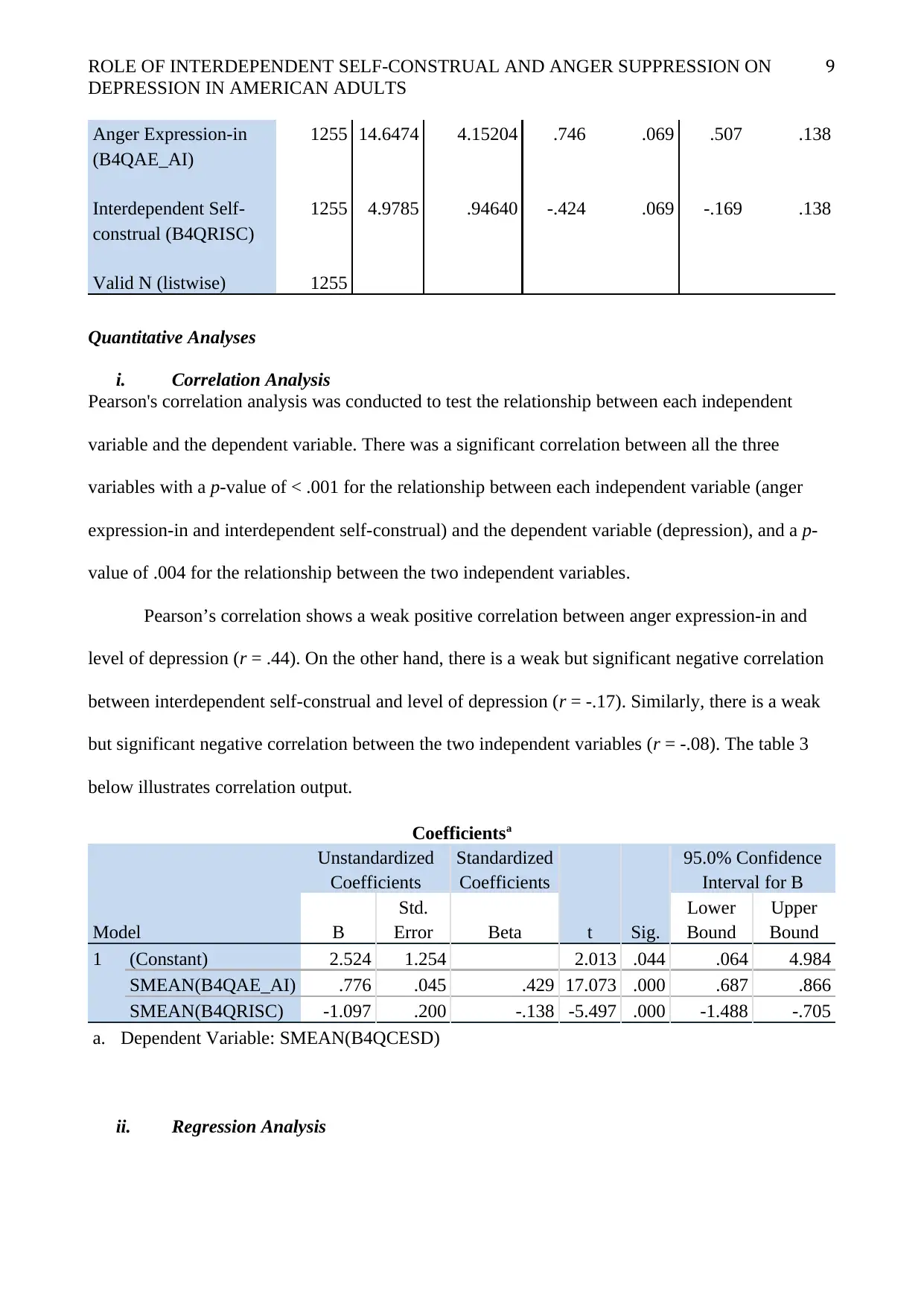
ROLE OF INTERDEPENDENT SELF-CONSTRUAL AND ANGER SUPPRESSION ON
DEPRESSION IN AMERICAN ADULTS
Anger Expression-in
(B4QAE_AI)
1255 14.6474 4.15204 .746 .069 .507 .138
Interdependent Self-
construal (B4QRISC)
1255 4.9785 .94640 -.424 .069 -.169 .138
Valid N (listwise) 1255
Quantitative Analyses
i. Correlation Analysis
Pearson's correlation analysis was conducted to test the relationship between each independent
variable and the dependent variable. There was a significant correlation between all the three
variables with a p-value of < .001 for the relationship between each independent variable (anger
expression-in and interdependent self-construal) and the dependent variable (depression), and a p-
value of .004 for the relationship between the two independent variables.
Pearson’s correlation shows a weak positive correlation between anger expression-in and
level of depression (r = .44). On the other hand, there is a weak but significant negative correlation
between interdependent self-construal and level of depression (r = -.17). Similarly, there is a weak
but significant negative correlation between the two independent variables (r = -.08). The table 3
below illustrates correlation output.
Coefficientsa
Model
Unstandardized
Coefficients
Standardized
Coefficients
t Sig.
95.0% Confidence
Interval for B
B
Std.
Error Beta
Lower
Bound
Upper
Bound
1 (Constant) 2.524 1.254 2.013 .044 .064 4.984
SMEAN(B4QAE_AI) .776 .045 .429 17.073 .000 .687 .866
SMEAN(B4QRISC) -1.097 .200 -.138 -5.497 .000 -1.488 -.705
a. Dependent Variable: SMEAN(B4QCESD)
ii. Regression Analysis
9
DEPRESSION IN AMERICAN ADULTS
Anger Expression-in
(B4QAE_AI)
1255 14.6474 4.15204 .746 .069 .507 .138
Interdependent Self-
construal (B4QRISC)
1255 4.9785 .94640 -.424 .069 -.169 .138
Valid N (listwise) 1255
Quantitative Analyses
i. Correlation Analysis
Pearson's correlation analysis was conducted to test the relationship between each independent
variable and the dependent variable. There was a significant correlation between all the three
variables with a p-value of < .001 for the relationship between each independent variable (anger
expression-in and interdependent self-construal) and the dependent variable (depression), and a p-
value of .004 for the relationship between the two independent variables.
Pearson’s correlation shows a weak positive correlation between anger expression-in and
level of depression (r = .44). On the other hand, there is a weak but significant negative correlation
between interdependent self-construal and level of depression (r = -.17). Similarly, there is a weak
but significant negative correlation between the two independent variables (r = -.08). The table 3
below illustrates correlation output.
Coefficientsa
Model
Unstandardized
Coefficients
Standardized
Coefficients
t Sig.
95.0% Confidence
Interval for B
B
Std.
Error Beta
Lower
Bound
Upper
Bound
1 (Constant) 2.524 1.254 2.013 .044 .064 4.984
SMEAN(B4QAE_AI) .776 .045 .429 17.073 .000 .687 .866
SMEAN(B4QRISC) -1.097 .200 -.138 -5.497 .000 -1.488 -.705
a. Dependent Variable: SMEAN(B4QCESD)
ii. Regression Analysis
9
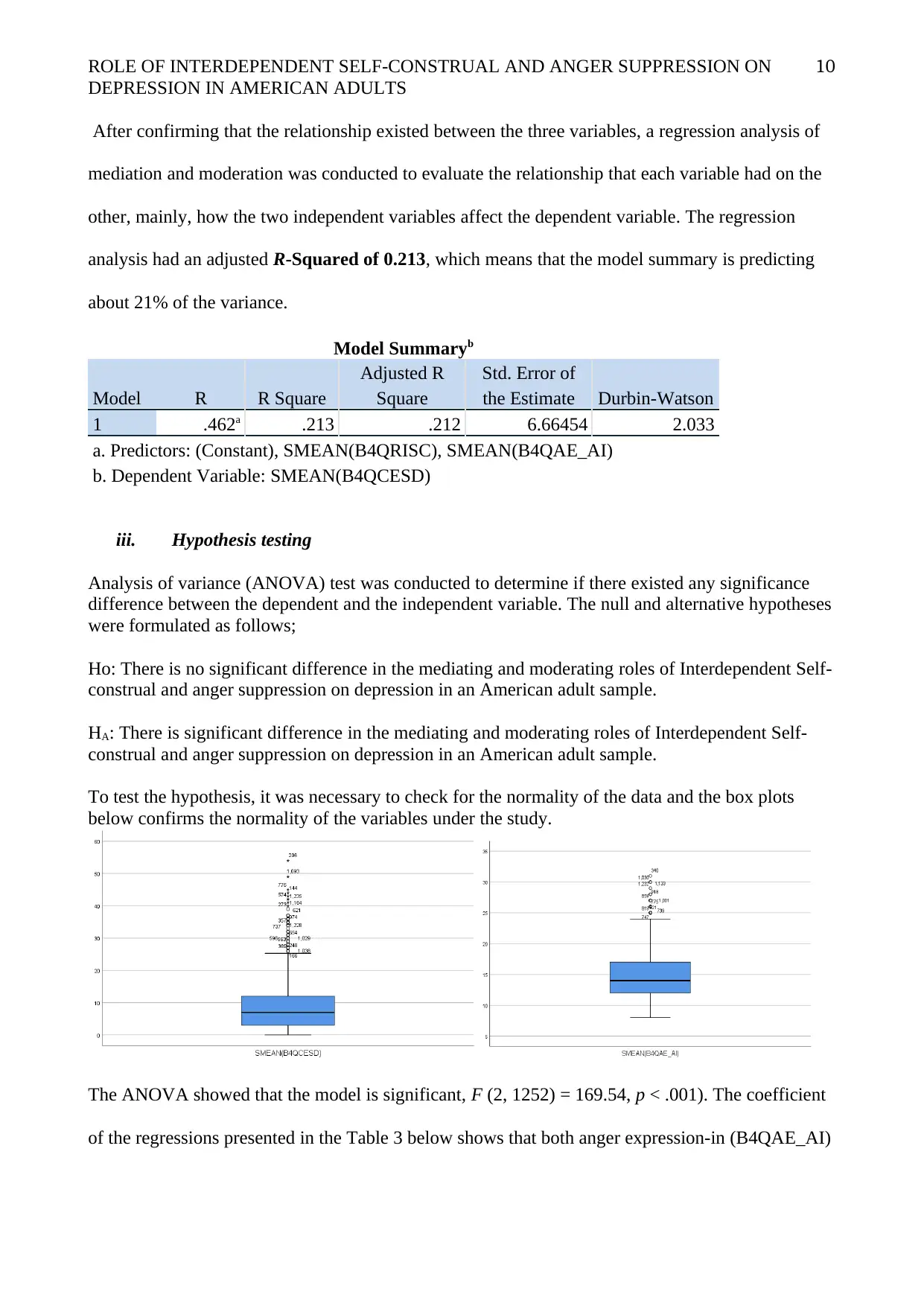
ROLE OF INTERDEPENDENT SELF-CONSTRUAL AND ANGER SUPPRESSION ON
DEPRESSION IN AMERICAN ADULTS
After confirming that the relationship existed between the three variables, a regression analysis of
mediation and moderation was conducted to evaluate the relationship that each variable had on the
other, mainly, how the two independent variables affect the dependent variable. The regression
analysis had an adjusted R-Squared of 0.213, which means that the model summary is predicting
about 21% of the variance.
Model Summaryb
Model R R Square
Adjusted R
Square
Std. Error of
the Estimate Durbin-Watson
1 .462a .213 .212 6.66454 2.033
a. Predictors: (Constant), SMEAN(B4QRISC), SMEAN(B4QAE_AI)
b. Dependent Variable: SMEAN(B4QCESD)
iii. Hypothesis testing
Analysis of variance (ANOVA) test was conducted to determine if there existed any significance
difference between the dependent and the independent variable. The null and alternative hypotheses
were formulated as follows;
Ho: There is no significant difference in the mediating and moderating roles of Interdependent Self-
construal and anger suppression on depression in an American adult sample.
HA: There is significant difference in the mediating and moderating roles of Interdependent Self-
construal and anger suppression on depression in an American adult sample.
To test the hypothesis, it was necessary to check for the normality of the data and the box plots
below confirms the normality of the variables under the study.
The ANOVA showed that the model is significant, F (2, 1252) = 169.54, p < .001). The coefficient
of the regressions presented in the Table 3 below shows that both anger expression-in (B4QAE_AI)
10
DEPRESSION IN AMERICAN ADULTS
After confirming that the relationship existed between the three variables, a regression analysis of
mediation and moderation was conducted to evaluate the relationship that each variable had on the
other, mainly, how the two independent variables affect the dependent variable. The regression
analysis had an adjusted R-Squared of 0.213, which means that the model summary is predicting
about 21% of the variance.
Model Summaryb
Model R R Square
Adjusted R
Square
Std. Error of
the Estimate Durbin-Watson
1 .462a .213 .212 6.66454 2.033
a. Predictors: (Constant), SMEAN(B4QRISC), SMEAN(B4QAE_AI)
b. Dependent Variable: SMEAN(B4QCESD)
iii. Hypothesis testing
Analysis of variance (ANOVA) test was conducted to determine if there existed any significance
difference between the dependent and the independent variable. The null and alternative hypotheses
were formulated as follows;
Ho: There is no significant difference in the mediating and moderating roles of Interdependent Self-
construal and anger suppression on depression in an American adult sample.
HA: There is significant difference in the mediating and moderating roles of Interdependent Self-
construal and anger suppression on depression in an American adult sample.
To test the hypothesis, it was necessary to check for the normality of the data and the box plots
below confirms the normality of the variables under the study.
The ANOVA showed that the model is significant, F (2, 1252) = 169.54, p < .001). The coefficient
of the regressions presented in the Table 3 below shows that both anger expression-in (B4QAE_AI)
10
Secure Best Marks with AI Grader
Need help grading? Try our AI Grader for instant feedback on your assignments.
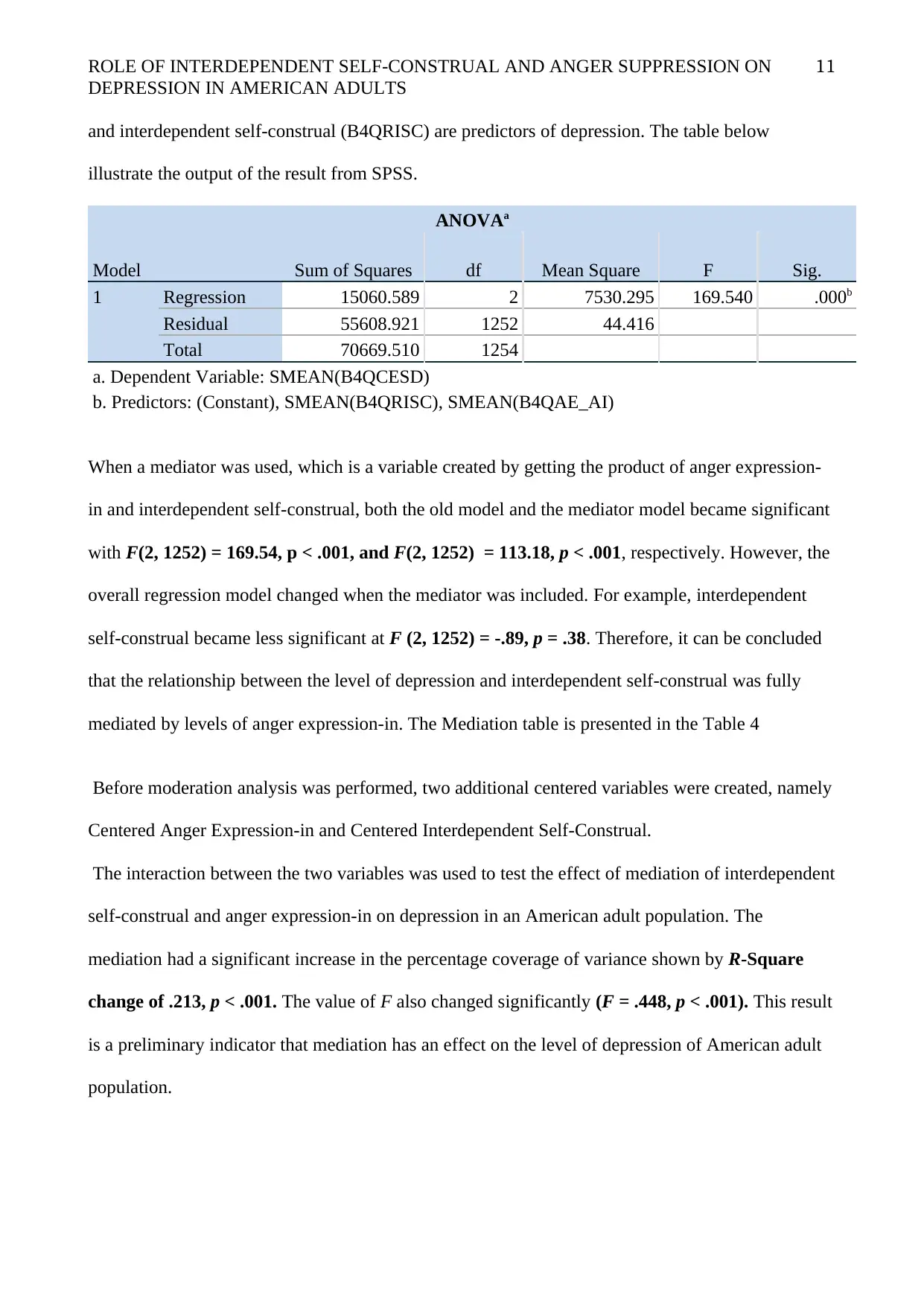
ROLE OF INTERDEPENDENT SELF-CONSTRUAL AND ANGER SUPPRESSION ON
DEPRESSION IN AMERICAN ADULTS
and interdependent self-construal (B4QRISC) are predictors of depression. The table below
illustrate the output of the result from SPSS.
ANOVAa
Model Sum of Squares df Mean Square F Sig.
1 Regression 15060.589 2 7530.295 169.540 .000b
Residual 55608.921 1252 44.416
Total 70669.510 1254
a. Dependent Variable: SMEAN(B4QCESD)
b. Predictors: (Constant), SMEAN(B4QRISC), SMEAN(B4QAE_AI)
When a mediator was used, which is a variable created by getting the product of anger expression-
in and interdependent self-construal, both the old model and the mediator model became significant
with F(2, 1252) = 169.54, p < .001, and F(2, 1252) = 113.18, p < .001, respectively. However, the
overall regression model changed when the mediator was included. For example, interdependent
self-construal became less significant at F (2, 1252) = -.89, p = .38. Therefore, it can be concluded
that the relationship between the level of depression and interdependent self-construal was fully
mediated by levels of anger expression-in. The Mediation table is presented in the Table 4
Before moderation analysis was performed, two additional centered variables were created, namely
Centered Anger Expression-in and Centered Interdependent Self-Construal.
The interaction between the two variables was used to test the effect of mediation of interdependent
self-construal and anger expression-in on depression in an American adult population. The
mediation had a significant increase in the percentage coverage of variance shown by R-Square
change of .213, p < .001. The value of F also changed significantly (F = .448, p < .001). This result
is a preliminary indicator that mediation has an effect on the level of depression of American adult
population.
11
DEPRESSION IN AMERICAN ADULTS
and interdependent self-construal (B4QRISC) are predictors of depression. The table below
illustrate the output of the result from SPSS.
ANOVAa
Model Sum of Squares df Mean Square F Sig.
1 Regression 15060.589 2 7530.295 169.540 .000b
Residual 55608.921 1252 44.416
Total 70669.510 1254
a. Dependent Variable: SMEAN(B4QCESD)
b. Predictors: (Constant), SMEAN(B4QRISC), SMEAN(B4QAE_AI)
When a mediator was used, which is a variable created by getting the product of anger expression-
in and interdependent self-construal, both the old model and the mediator model became significant
with F(2, 1252) = 169.54, p < .001, and F(2, 1252) = 113.18, p < .001, respectively. However, the
overall regression model changed when the mediator was included. For example, interdependent
self-construal became less significant at F (2, 1252) = -.89, p = .38. Therefore, it can be concluded
that the relationship between the level of depression and interdependent self-construal was fully
mediated by levels of anger expression-in. The Mediation table is presented in the Table 4
Before moderation analysis was performed, two additional centered variables were created, namely
Centered Anger Expression-in and Centered Interdependent Self-Construal.
The interaction between the two variables was used to test the effect of mediation of interdependent
self-construal and anger expression-in on depression in an American adult population. The
mediation had a significant increase in the percentage coverage of variance shown by R-Square
change of .213, p < .001. The value of F also changed significantly (F = .448, p < .001). This result
is a preliminary indicator that mediation has an effect on the level of depression of American adult
population.
11
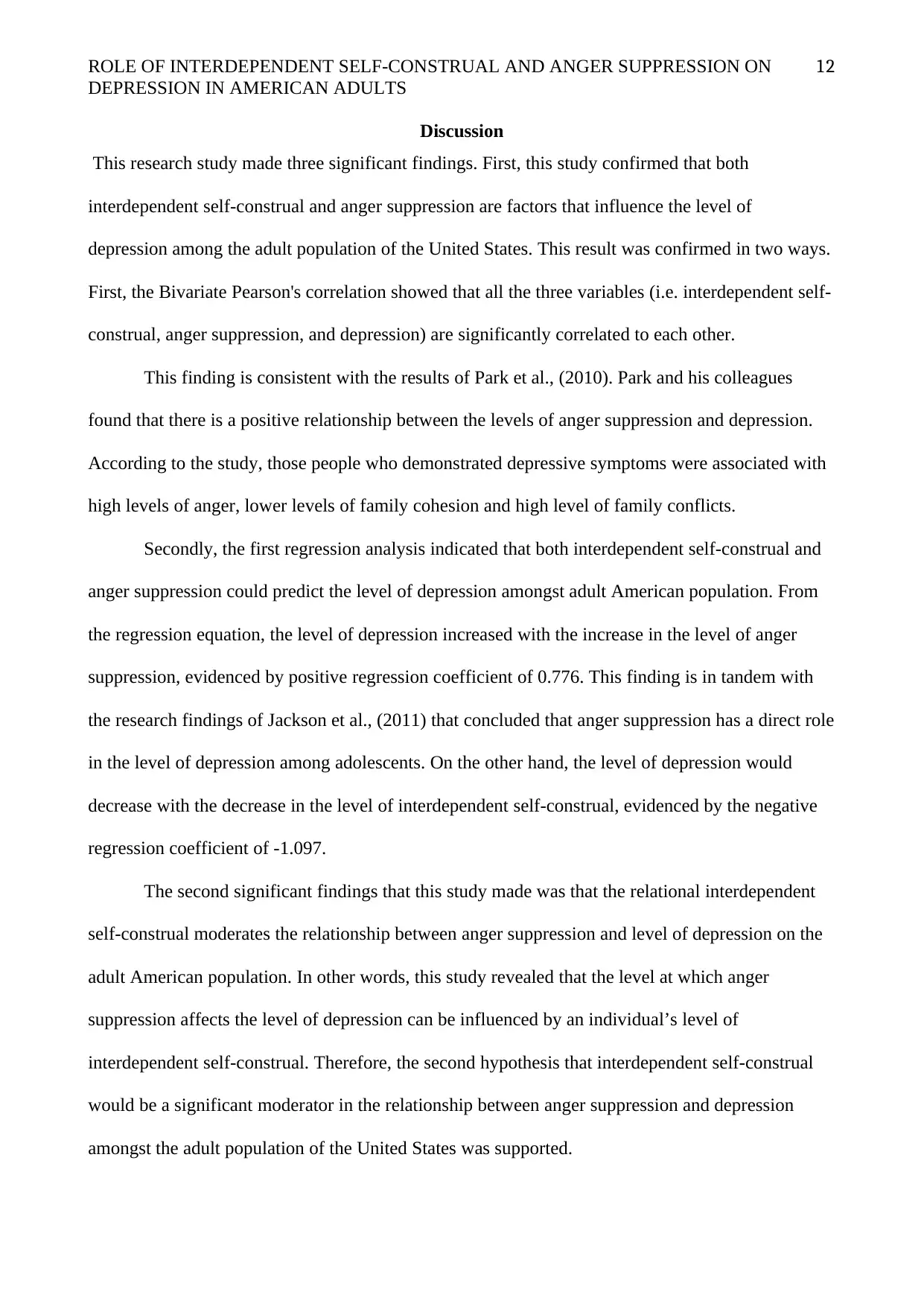
ROLE OF INTERDEPENDENT SELF-CONSTRUAL AND ANGER SUPPRESSION ON
DEPRESSION IN AMERICAN ADULTS
Discussion
This research study made three significant findings. First, this study confirmed that both
interdependent self-construal and anger suppression are factors that influence the level of
depression among the adult population of the United States. This result was confirmed in two ways.
First, the Bivariate Pearson's correlation showed that all the three variables (i.e. interdependent self-
construal, anger suppression, and depression) are significantly correlated to each other.
This finding is consistent with the results of Park et al., (2010). Park and his colleagues
found that there is a positive relationship between the levels of anger suppression and depression.
According to the study, those people who demonstrated depressive symptoms were associated with
high levels of anger, lower levels of family cohesion and high level of family conflicts.
Secondly, the first regression analysis indicated that both interdependent self-construal and
anger suppression could predict the level of depression amongst adult American population. From
the regression equation, the level of depression increased with the increase in the level of anger
suppression, evidenced by positive regression coefficient of 0.776. This finding is in tandem with
the research findings of Jackson et al., (2011) that concluded that anger suppression has a direct role
in the level of depression among adolescents. On the other hand, the level of depression would
decrease with the decrease in the level of interdependent self-construal, evidenced by the negative
regression coefficient of -1.097.
The second significant findings that this study made was that the relational interdependent
self-construal moderates the relationship between anger suppression and level of depression on the
adult American population. In other words, this study revealed that the level at which anger
suppression affects the level of depression can be influenced by an individual’s level of
interdependent self-construal. Therefore, the second hypothesis that interdependent self-construal
would be a significant moderator in the relationship between anger suppression and depression
amongst the adult population of the United States was supported.
12
DEPRESSION IN AMERICAN ADULTS
Discussion
This research study made three significant findings. First, this study confirmed that both
interdependent self-construal and anger suppression are factors that influence the level of
depression among the adult population of the United States. This result was confirmed in two ways.
First, the Bivariate Pearson's correlation showed that all the three variables (i.e. interdependent self-
construal, anger suppression, and depression) are significantly correlated to each other.
This finding is consistent with the results of Park et al., (2010). Park and his colleagues
found that there is a positive relationship between the levels of anger suppression and depression.
According to the study, those people who demonstrated depressive symptoms were associated with
high levels of anger, lower levels of family cohesion and high level of family conflicts.
Secondly, the first regression analysis indicated that both interdependent self-construal and
anger suppression could predict the level of depression amongst adult American population. From
the regression equation, the level of depression increased with the increase in the level of anger
suppression, evidenced by positive regression coefficient of 0.776. This finding is in tandem with
the research findings of Jackson et al., (2011) that concluded that anger suppression has a direct role
in the level of depression among adolescents. On the other hand, the level of depression would
decrease with the decrease in the level of interdependent self-construal, evidenced by the negative
regression coefficient of -1.097.
The second significant findings that this study made was that the relational interdependent
self-construal moderates the relationship between anger suppression and level of depression on the
adult American population. In other words, this study revealed that the level at which anger
suppression affects the level of depression can be influenced by an individual’s level of
interdependent self-construal. Therefore, the second hypothesis that interdependent self-construal
would be a significant moderator in the relationship between anger suppression and depression
amongst the adult population of the United States was supported.
12
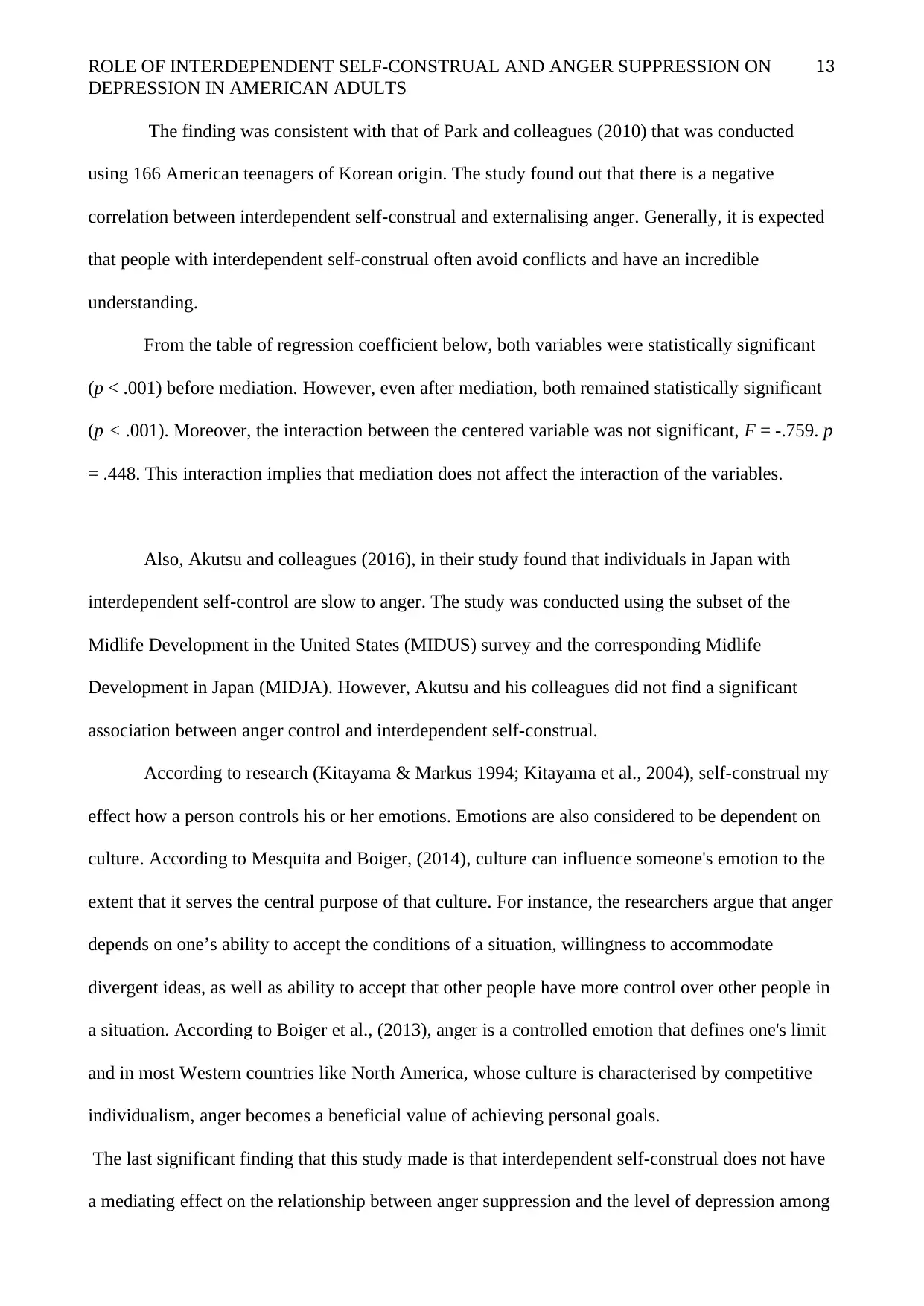
ROLE OF INTERDEPENDENT SELF-CONSTRUAL AND ANGER SUPPRESSION ON
DEPRESSION IN AMERICAN ADULTS
The finding was consistent with that of Park and colleagues (2010) that was conducted
using 166 American teenagers of Korean origin. The study found out that there is a negative
correlation between interdependent self-construal and externalising anger. Generally, it is expected
that people with interdependent self-construal often avoid conflicts and have an incredible
understanding.
From the table of regression coefficient below, both variables were statistically significant
(p < .001) before mediation. However, even after mediation, both remained statistically significant
(p < .001). Moreover, the interaction between the centered variable was not significant, F = -.759. p
= .448. This interaction implies that mediation does not affect the interaction of the variables.
Also, Akutsu and colleagues (2016), in their study found that individuals in Japan with
interdependent self-control are slow to anger. The study was conducted using the subset of the
Midlife Development in the United States (MIDUS) survey and the corresponding Midlife
Development in Japan (MIDJA). However, Akutsu and his colleagues did not find a significant
association between anger control and interdependent self-construal.
According to research (Kitayama & Markus 1994; Kitayama et al., 2004), self-construal my
effect how a person controls his or her emotions. Emotions are also considered to be dependent on
culture. According to Mesquita and Boiger, (2014), culture can influence someone's emotion to the
extent that it serves the central purpose of that culture. For instance, the researchers argue that anger
depends on one’s ability to accept the conditions of a situation, willingness to accommodate
divergent ideas, as well as ability to accept that other people have more control over other people in
a situation. According to Boiger et al., (2013), anger is a controlled emotion that defines one's limit
and in most Western countries like North America, whose culture is characterised by competitive
individualism, anger becomes a beneficial value of achieving personal goals.
The last significant finding that this study made is that interdependent self-construal does not have
a mediating effect on the relationship between anger suppression and the level of depression among
13
DEPRESSION IN AMERICAN ADULTS
The finding was consistent with that of Park and colleagues (2010) that was conducted
using 166 American teenagers of Korean origin. The study found out that there is a negative
correlation between interdependent self-construal and externalising anger. Generally, it is expected
that people with interdependent self-construal often avoid conflicts and have an incredible
understanding.
From the table of regression coefficient below, both variables were statistically significant
(p < .001) before mediation. However, even after mediation, both remained statistically significant
(p < .001). Moreover, the interaction between the centered variable was not significant, F = -.759. p
= .448. This interaction implies that mediation does not affect the interaction of the variables.
Also, Akutsu and colleagues (2016), in their study found that individuals in Japan with
interdependent self-control are slow to anger. The study was conducted using the subset of the
Midlife Development in the United States (MIDUS) survey and the corresponding Midlife
Development in Japan (MIDJA). However, Akutsu and his colleagues did not find a significant
association between anger control and interdependent self-construal.
According to research (Kitayama & Markus 1994; Kitayama et al., 2004), self-construal my
effect how a person controls his or her emotions. Emotions are also considered to be dependent on
culture. According to Mesquita and Boiger, (2014), culture can influence someone's emotion to the
extent that it serves the central purpose of that culture. For instance, the researchers argue that anger
depends on one’s ability to accept the conditions of a situation, willingness to accommodate
divergent ideas, as well as ability to accept that other people have more control over other people in
a situation. According to Boiger et al., (2013), anger is a controlled emotion that defines one's limit
and in most Western countries like North America, whose culture is characterised by competitive
individualism, anger becomes a beneficial value of achieving personal goals.
The last significant finding that this study made is that interdependent self-construal does not have
a mediating effect on the relationship between anger suppression and the level of depression among
13
Paraphrase This Document
Need a fresh take? Get an instant paraphrase of this document with our AI Paraphraser
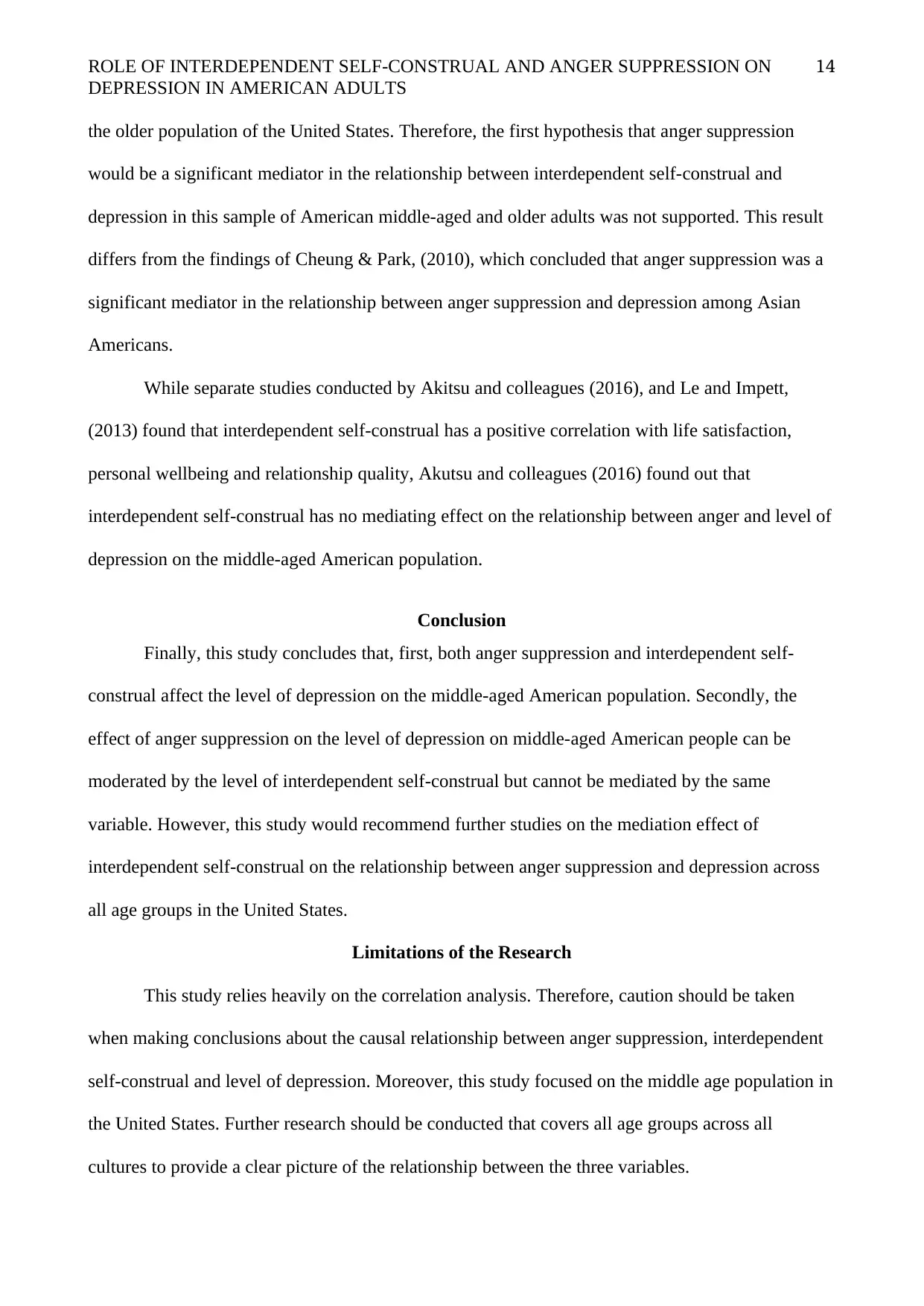
ROLE OF INTERDEPENDENT SELF-CONSTRUAL AND ANGER SUPPRESSION ON
DEPRESSION IN AMERICAN ADULTS
the older population of the United States. Therefore, the first hypothesis that anger suppression
would be a significant mediator in the relationship between interdependent self-construal and
depression in this sample of American middle-aged and older adults was not supported. This result
differs from the findings of Cheung & Park, (2010), which concluded that anger suppression was a
significant mediator in the relationship between anger suppression and depression among Asian
Americans.
While separate studies conducted by Akitsu and colleagues (2016), and Le and Impett,
(2013) found that interdependent self-construal has a positive correlation with life satisfaction,
personal wellbeing and relationship quality, Akutsu and colleagues (2016) found out that
interdependent self-construal has no mediating effect on the relationship between anger and level of
depression on the middle-aged American population.
Conclusion
Finally, this study concludes that, first, both anger suppression and interdependent self-
construal affect the level of depression on the middle-aged American population. Secondly, the
effect of anger suppression on the level of depression on middle-aged American people can be
moderated by the level of interdependent self-construal but cannot be mediated by the same
variable. However, this study would recommend further studies on the mediation effect of
interdependent self-construal on the relationship between anger suppression and depression across
all age groups in the United States.
Limitations of the Research
This study relies heavily on the correlation analysis. Therefore, caution should be taken
when making conclusions about the causal relationship between anger suppression, interdependent
self-construal and level of depression. Moreover, this study focused on the middle age population in
the United States. Further research should be conducted that covers all age groups across all
cultures to provide a clear picture of the relationship between the three variables.
14
DEPRESSION IN AMERICAN ADULTS
the older population of the United States. Therefore, the first hypothesis that anger suppression
would be a significant mediator in the relationship between interdependent self-construal and
depression in this sample of American middle-aged and older adults was not supported. This result
differs from the findings of Cheung & Park, (2010), which concluded that anger suppression was a
significant mediator in the relationship between anger suppression and depression among Asian
Americans.
While separate studies conducted by Akitsu and colleagues (2016), and Le and Impett,
(2013) found that interdependent self-construal has a positive correlation with life satisfaction,
personal wellbeing and relationship quality, Akutsu and colleagues (2016) found out that
interdependent self-construal has no mediating effect on the relationship between anger and level of
depression on the middle-aged American population.
Conclusion
Finally, this study concludes that, first, both anger suppression and interdependent self-
construal affect the level of depression on the middle-aged American population. Secondly, the
effect of anger suppression on the level of depression on middle-aged American people can be
moderated by the level of interdependent self-construal but cannot be mediated by the same
variable. However, this study would recommend further studies on the mediation effect of
interdependent self-construal on the relationship between anger suppression and depression across
all age groups in the United States.
Limitations of the Research
This study relies heavily on the correlation analysis. Therefore, caution should be taken
when making conclusions about the causal relationship between anger suppression, interdependent
self-construal and level of depression. Moreover, this study focused on the middle age population in
the United States. Further research should be conducted that covers all age groups across all
cultures to provide a clear picture of the relationship between the three variables.
14
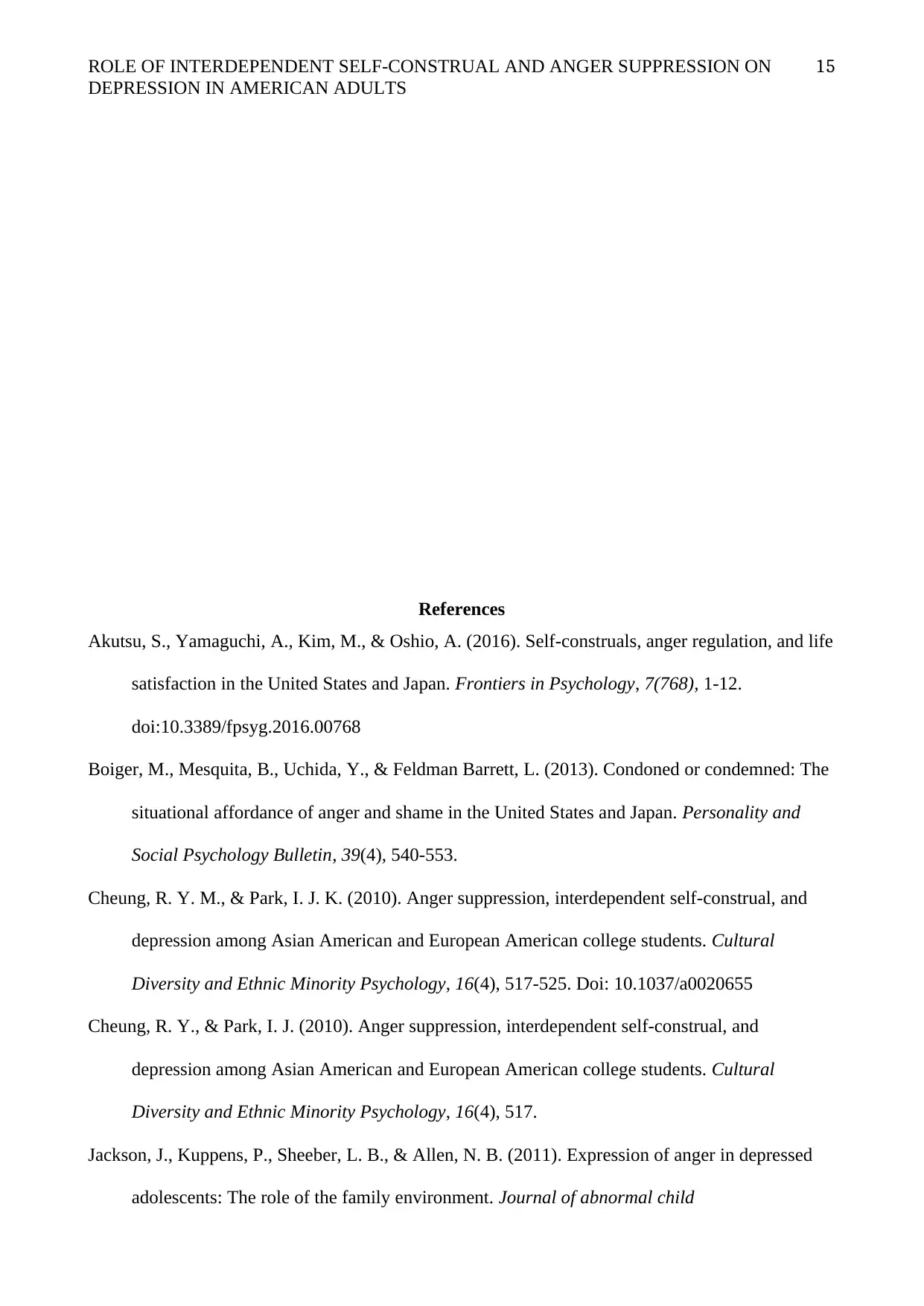
ROLE OF INTERDEPENDENT SELF-CONSTRUAL AND ANGER SUPPRESSION ON
DEPRESSION IN AMERICAN ADULTS
References
Akutsu, S., Yamaguchi, A., Kim, M., & Oshio, A. (2016). Self-construals, anger regulation, and life
satisfaction in the United States and Japan. Frontiers in Psychology, 7(768), 1-12.
doi:10.3389/fpsyg.2016.00768
Boiger, M., Mesquita, B., Uchida, Y., & Feldman Barrett, L. (2013). Condoned or condemned: The
situational affordance of anger and shame in the United States and Japan. Personality and
Social Psychology Bulletin, 39(4), 540-553.
Cheung, R. Y. M., & Park, I. J. K. (2010). Anger suppression, interdependent self-construal, and
depression among Asian American and European American college students. Cultural
Diversity and Ethnic Minority Psychology, 16(4), 517-525. Doi: 10.1037/a0020655
Cheung, R. Y., & Park, I. J. (2010). Anger suppression, interdependent self-construal, and
depression among Asian American and European American college students. Cultural
Diversity and Ethnic Minority Psychology, 16(4), 517.
Jackson, J., Kuppens, P., Sheeber, L. B., & Allen, N. B. (2011). Expression of anger in depressed
adolescents: The role of the family environment. Journal of abnormal child
15
DEPRESSION IN AMERICAN ADULTS
References
Akutsu, S., Yamaguchi, A., Kim, M., & Oshio, A. (2016). Self-construals, anger regulation, and life
satisfaction in the United States and Japan. Frontiers in Psychology, 7(768), 1-12.
doi:10.3389/fpsyg.2016.00768
Boiger, M., Mesquita, B., Uchida, Y., & Feldman Barrett, L. (2013). Condoned or condemned: The
situational affordance of anger and shame in the United States and Japan. Personality and
Social Psychology Bulletin, 39(4), 540-553.
Cheung, R. Y. M., & Park, I. J. K. (2010). Anger suppression, interdependent self-construal, and
depression among Asian American and European American college students. Cultural
Diversity and Ethnic Minority Psychology, 16(4), 517-525. Doi: 10.1037/a0020655
Cheung, R. Y., & Park, I. J. (2010). Anger suppression, interdependent self-construal, and
depression among Asian American and European American college students. Cultural
Diversity and Ethnic Minority Psychology, 16(4), 517.
Jackson, J., Kuppens, P., Sheeber, L. B., & Allen, N. B. (2011). Expression of anger in depressed
adolescents: The role of the family environment. Journal of abnormal child
15
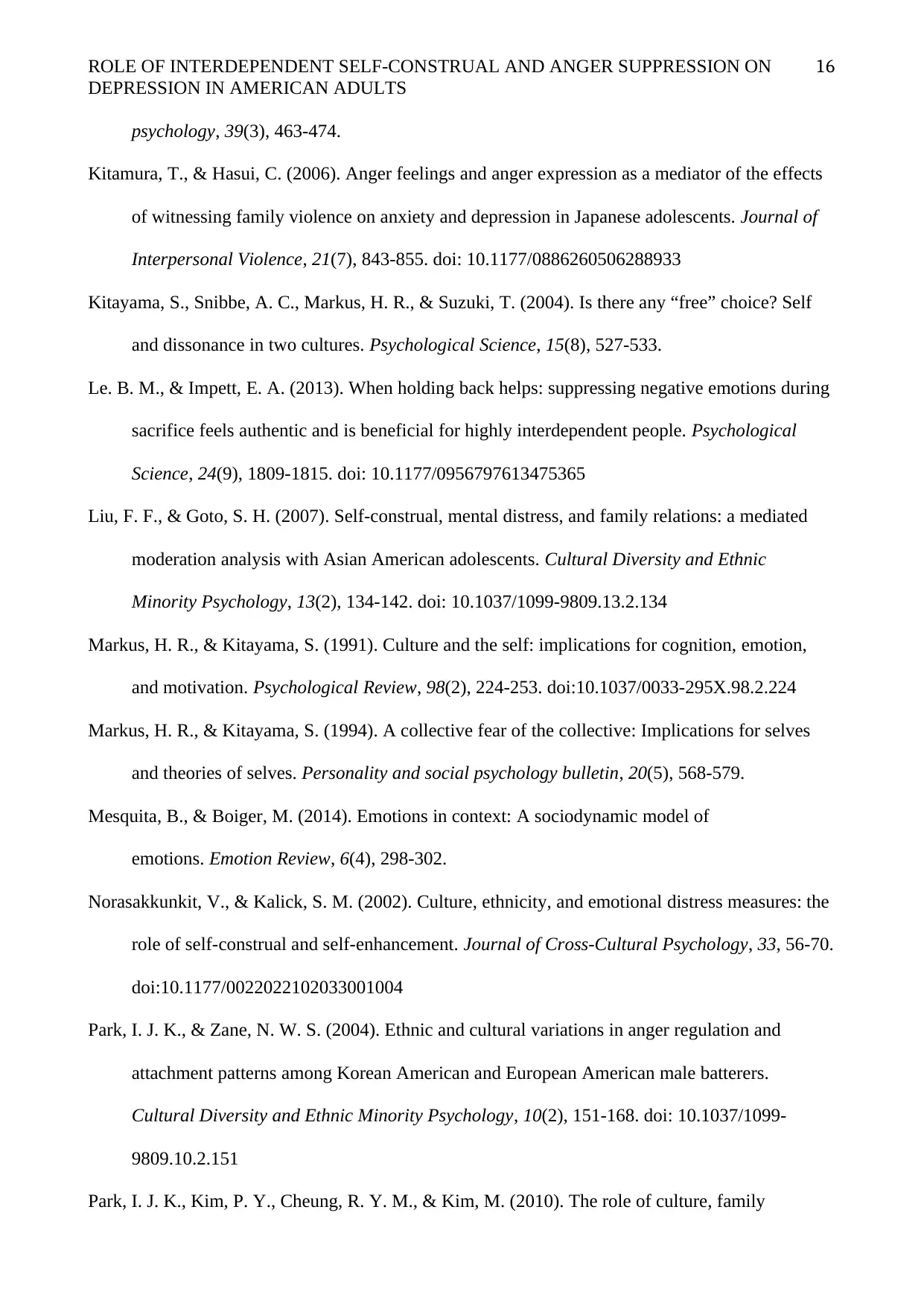
ROLE OF INTERDEPENDENT SELF-CONSTRUAL AND ANGER SUPPRESSION ON
DEPRESSION IN AMERICAN ADULTS
psychology, 39(3), 463-474.
Kitamura, T., & Hasui, C. (2006). Anger feelings and anger expression as a mediator of the effects
of witnessing family violence on anxiety and depression in Japanese adolescents. Journal of
Interpersonal Violence, 21(7), 843-855. doi: 10.1177/0886260506288933
Kitayama, S., Snibbe, A. C., Markus, H. R., & Suzuki, T. (2004). Is there any “free” choice? Self
and dissonance in two cultures. Psychological Science, 15(8), 527-533.
Le. B. M., & Impett, E. A. (2013). When holding back helps: suppressing negative emotions during
sacrifice feels authentic and is beneficial for highly interdependent people. Psychological
Science, 24(9), 1809-1815. doi: 10.1177/0956797613475365
Liu, F. F., & Goto, S. H. (2007). Self-construal, mental distress, and family relations: a mediated
moderation analysis with Asian American adolescents. Cultural Diversity and Ethnic
Minority Psychology, 13(2), 134-142. doi: 10.1037/1099-9809.13.2.134
Markus, H. R., & Kitayama, S. (1991). Culture and the self: implications for cognition, emotion,
and motivation. Psychological Review, 98(2), 224-253. doi:10.1037/0033-295X.98.2.224
Markus, H. R., & Kitayama, S. (1994). A collective fear of the collective: Implications for selves
and theories of selves. Personality and social psychology bulletin, 20(5), 568-579.
Mesquita, B., & Boiger, M. (2014). Emotions in context: A sociodynamic model of
emotions. Emotion Review, 6(4), 298-302.
Norasakkunkit, V., & Kalick, S. M. (2002). Culture, ethnicity, and emotional distress measures: the
role of self-construal and self-enhancement. Journal of Cross-Cultural Psychology, 33, 56-70.
doi:10.1177/0022022102033001004
Park, I. J. K., & Zane, N. W. S. (2004). Ethnic and cultural variations in anger regulation and
attachment patterns among Korean American and European American male batterers.
Cultural Diversity and Ethnic Minority Psychology, 10(2), 151-168. doi: 10.1037/1099-
9809.10.2.151
Park, I. J. K., Kim, P. Y., Cheung, R. Y. M., & Kim, M. (2010). The role of culture, family
16
DEPRESSION IN AMERICAN ADULTS
psychology, 39(3), 463-474.
Kitamura, T., & Hasui, C. (2006). Anger feelings and anger expression as a mediator of the effects
of witnessing family violence on anxiety and depression in Japanese adolescents. Journal of
Interpersonal Violence, 21(7), 843-855. doi: 10.1177/0886260506288933
Kitayama, S., Snibbe, A. C., Markus, H. R., & Suzuki, T. (2004). Is there any “free” choice? Self
and dissonance in two cultures. Psychological Science, 15(8), 527-533.
Le. B. M., & Impett, E. A. (2013). When holding back helps: suppressing negative emotions during
sacrifice feels authentic and is beneficial for highly interdependent people. Psychological
Science, 24(9), 1809-1815. doi: 10.1177/0956797613475365
Liu, F. F., & Goto, S. H. (2007). Self-construal, mental distress, and family relations: a mediated
moderation analysis with Asian American adolescents. Cultural Diversity and Ethnic
Minority Psychology, 13(2), 134-142. doi: 10.1037/1099-9809.13.2.134
Markus, H. R., & Kitayama, S. (1991). Culture and the self: implications for cognition, emotion,
and motivation. Psychological Review, 98(2), 224-253. doi:10.1037/0033-295X.98.2.224
Markus, H. R., & Kitayama, S. (1994). A collective fear of the collective: Implications for selves
and theories of selves. Personality and social psychology bulletin, 20(5), 568-579.
Mesquita, B., & Boiger, M. (2014). Emotions in context: A sociodynamic model of
emotions. Emotion Review, 6(4), 298-302.
Norasakkunkit, V., & Kalick, S. M. (2002). Culture, ethnicity, and emotional distress measures: the
role of self-construal and self-enhancement. Journal of Cross-Cultural Psychology, 33, 56-70.
doi:10.1177/0022022102033001004
Park, I. J. K., & Zane, N. W. S. (2004). Ethnic and cultural variations in anger regulation and
attachment patterns among Korean American and European American male batterers.
Cultural Diversity and Ethnic Minority Psychology, 10(2), 151-168. doi: 10.1037/1099-
9809.10.2.151
Park, I. J. K., Kim, P. Y., Cheung, R. Y. M., & Kim, M. (2010). The role of culture, family
16
Secure Best Marks with AI Grader
Need help grading? Try our AI Grader for instant feedback on your assignments.
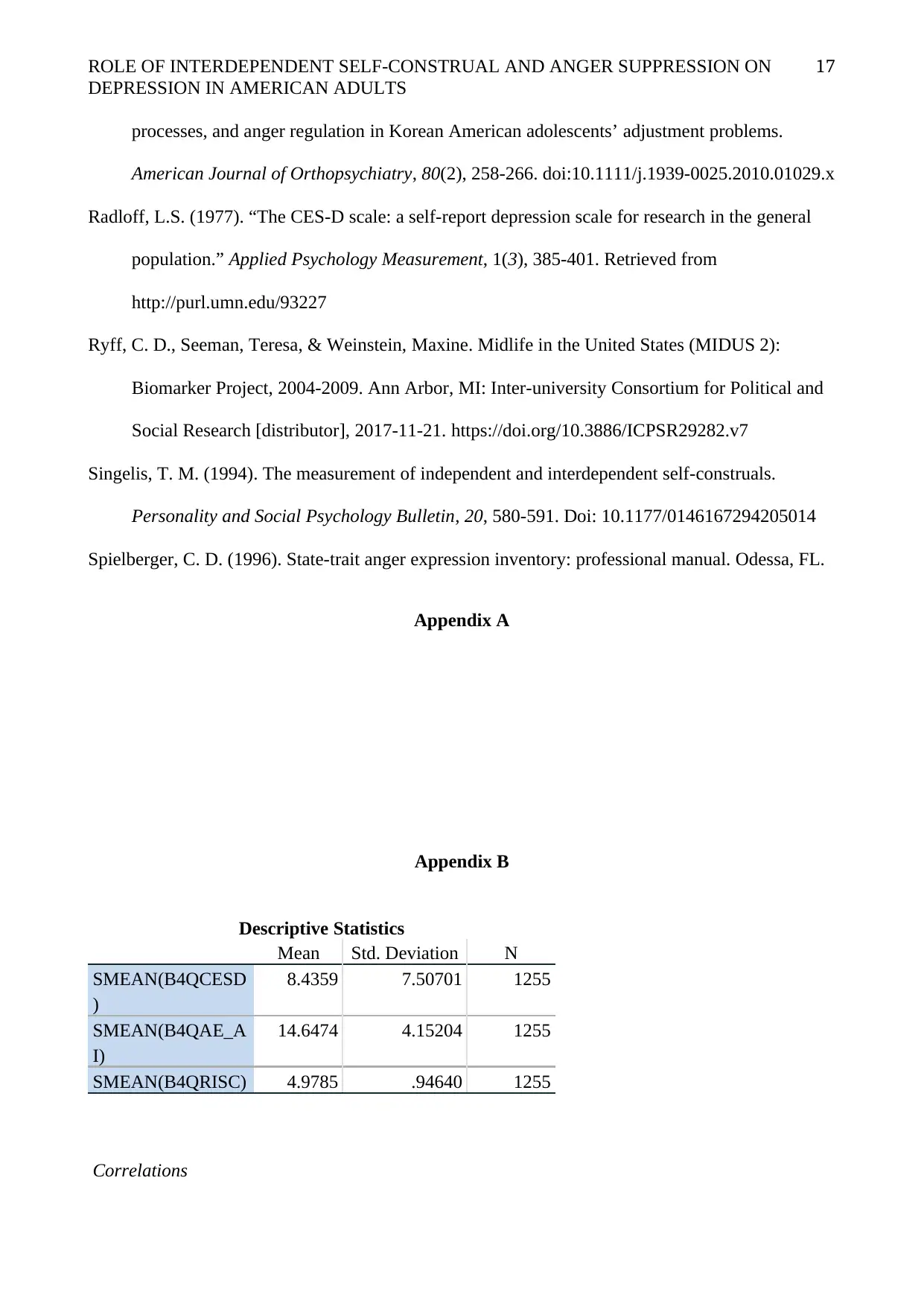
ROLE OF INTERDEPENDENT SELF-CONSTRUAL AND ANGER SUPPRESSION ON
DEPRESSION IN AMERICAN ADULTS
processes, and anger regulation in Korean American adolescents’ adjustment problems.
American Journal of Orthopsychiatry, 80(2), 258-266. doi:10.1111/j.1939-0025.2010.01029.x
Radloff, L.S. (1977). “The CES-D scale: a self-report depression scale for research in the general
population.” Applied Psychology Measurement, 1(3), 385-401. Retrieved from
http://purl.umn.edu/93227
Ryff, C. D., Seeman, Teresa, & Weinstein, Maxine. Midlife in the United States (MIDUS 2):
Biomarker Project, 2004-2009. Ann Arbor, MI: Inter-university Consortium for Political and
Social Research [distributor], 2017-11-21. https://doi.org/10.3886/ICPSR29282.v7
Singelis, T. M. (1994). The measurement of independent and interdependent self-construals.
Personality and Social Psychology Bulletin, 20, 580-591. Doi: 10.1177/0146167294205014
Spielberger, C. D. (1996). State-trait anger expression inventory: professional manual. Odessa, FL.
Appendix A
Appendix B
Descriptive Statistics
Mean Std. Deviation N
SMEAN(B4QCESD
)
8.4359 7.50701 1255
SMEAN(B4QAE_A
I)
14.6474 4.15204 1255
SMEAN(B4QRISC) 4.9785 .94640 1255
Correlations
17
DEPRESSION IN AMERICAN ADULTS
processes, and anger regulation in Korean American adolescents’ adjustment problems.
American Journal of Orthopsychiatry, 80(2), 258-266. doi:10.1111/j.1939-0025.2010.01029.x
Radloff, L.S. (1977). “The CES-D scale: a self-report depression scale for research in the general
population.” Applied Psychology Measurement, 1(3), 385-401. Retrieved from
http://purl.umn.edu/93227
Ryff, C. D., Seeman, Teresa, & Weinstein, Maxine. Midlife in the United States (MIDUS 2):
Biomarker Project, 2004-2009. Ann Arbor, MI: Inter-university Consortium for Political and
Social Research [distributor], 2017-11-21. https://doi.org/10.3886/ICPSR29282.v7
Singelis, T. M. (1994). The measurement of independent and interdependent self-construals.
Personality and Social Psychology Bulletin, 20, 580-591. Doi: 10.1177/0146167294205014
Spielberger, C. D. (1996). State-trait anger expression inventory: professional manual. Odessa, FL.
Appendix A
Appendix B
Descriptive Statistics
Mean Std. Deviation N
SMEAN(B4QCESD
)
8.4359 7.50701 1255
SMEAN(B4QAE_A
I)
14.6474 4.15204 1255
SMEAN(B4QRISC) 4.9785 .94640 1255
Correlations
17
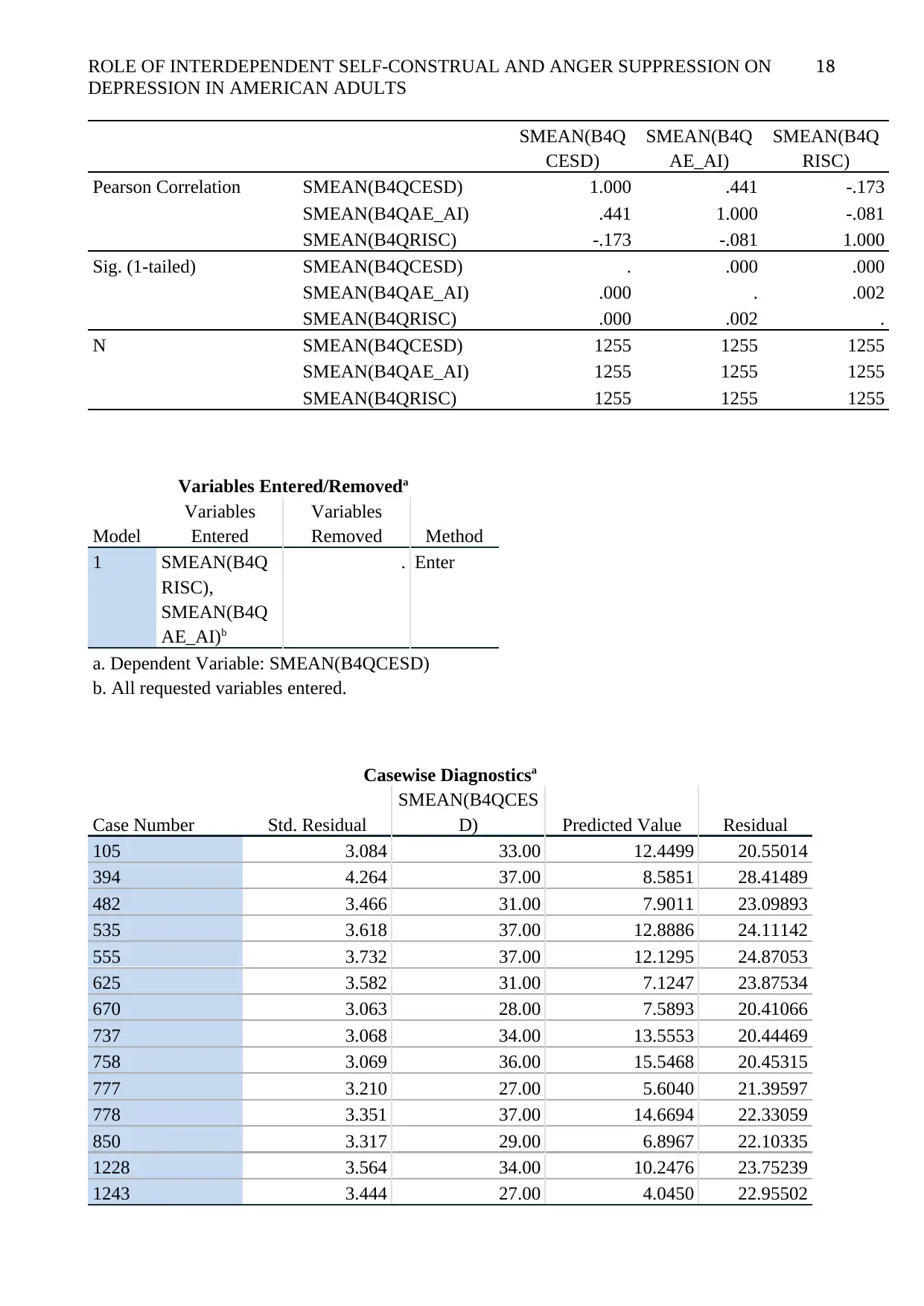
ROLE OF INTERDEPENDENT SELF-CONSTRUAL AND ANGER SUPPRESSION ON
DEPRESSION IN AMERICAN ADULTS
SMEAN(B4Q
CESD)
SMEAN(B4Q
AE_AI)
SMEAN(B4Q
RISC)
Pearson Correlation SMEAN(B4QCESD) 1.000 .441 -.173
SMEAN(B4QAE_AI) .441 1.000 -.081
SMEAN(B4QRISC) -.173 -.081 1.000
Sig. (1-tailed) SMEAN(B4QCESD) . .000 .000
SMEAN(B4QAE_AI) .000 . .002
SMEAN(B4QRISC) .000 .002 .
N SMEAN(B4QCESD) 1255 1255 1255
SMEAN(B4QAE_AI) 1255 1255 1255
SMEAN(B4QRISC) 1255 1255 1255
Variables Entered/Removeda
Model
Variables
Entered
Variables
Removed Method
1 SMEAN(B4Q
RISC),
SMEAN(B4Q
AE_AI)b
. Enter
a. Dependent Variable: SMEAN(B4QCESD)
b. All requested variables entered.
Casewise Diagnosticsa
Case Number Std. Residual
SMEAN(B4QCES
D) Predicted Value Residual
105 3.084 33.00 12.4499 20.55014
394 4.264 37.00 8.5851 28.41489
482 3.466 31.00 7.9011 23.09893
535 3.618 37.00 12.8886 24.11142
555 3.732 37.00 12.1295 24.87053
625 3.582 31.00 7.1247 23.87534
670 3.063 28.00 7.5893 20.41066
737 3.068 34.00 13.5553 20.44469
758 3.069 36.00 15.5468 20.45315
777 3.210 27.00 5.6040 21.39597
778 3.351 37.00 14.6694 22.33059
850 3.317 29.00 6.8967 22.10335
1228 3.564 34.00 10.2476 23.75239
1243 3.444 27.00 4.0450 22.95502
18
DEPRESSION IN AMERICAN ADULTS
SMEAN(B4Q
CESD)
SMEAN(B4Q
AE_AI)
SMEAN(B4Q
RISC)
Pearson Correlation SMEAN(B4QCESD) 1.000 .441 -.173
SMEAN(B4QAE_AI) .441 1.000 -.081
SMEAN(B4QRISC) -.173 -.081 1.000
Sig. (1-tailed) SMEAN(B4QCESD) . .000 .000
SMEAN(B4QAE_AI) .000 . .002
SMEAN(B4QRISC) .000 .002 .
N SMEAN(B4QCESD) 1255 1255 1255
SMEAN(B4QAE_AI) 1255 1255 1255
SMEAN(B4QRISC) 1255 1255 1255
Variables Entered/Removeda
Model
Variables
Entered
Variables
Removed Method
1 SMEAN(B4Q
RISC),
SMEAN(B4Q
AE_AI)b
. Enter
a. Dependent Variable: SMEAN(B4QCESD)
b. All requested variables entered.
Casewise Diagnosticsa
Case Number Std. Residual
SMEAN(B4QCES
D) Predicted Value Residual
105 3.084 33.00 12.4499 20.55014
394 4.264 37.00 8.5851 28.41489
482 3.466 31.00 7.9011 23.09893
535 3.618 37.00 12.8886 24.11142
555 3.732 37.00 12.1295 24.87053
625 3.582 31.00 7.1247 23.87534
670 3.063 28.00 7.5893 20.41066
737 3.068 34.00 13.5553 20.44469
758 3.069 36.00 15.5468 20.45315
777 3.210 27.00 5.6040 21.39597
778 3.351 37.00 14.6694 22.33059
850 3.317 29.00 6.8967 22.10335
1228 3.564 34.00 10.2476 23.75239
1243 3.444 27.00 4.0450 22.95502
18
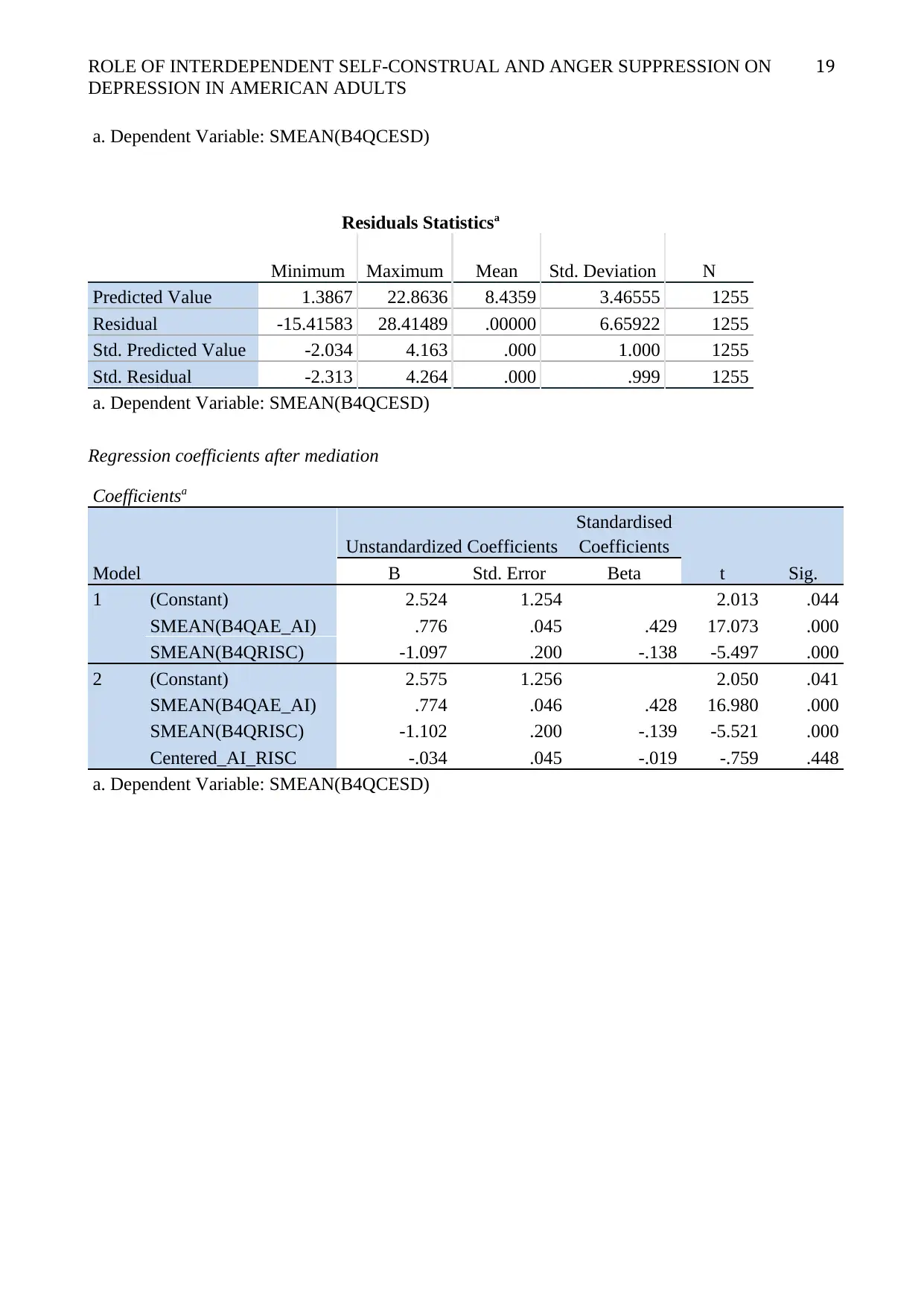
ROLE OF INTERDEPENDENT SELF-CONSTRUAL AND ANGER SUPPRESSION ON
DEPRESSION IN AMERICAN ADULTS
a. Dependent Variable: SMEAN(B4QCESD)
Residuals Statisticsa
Minimum Maximum Mean Std. Deviation N
Predicted Value 1.3867 22.8636 8.4359 3.46555 1255
Residual -15.41583 28.41489 .00000 6.65922 1255
Std. Predicted Value -2.034 4.163 .000 1.000 1255
Std. Residual -2.313 4.264 .000 .999 1255
a. Dependent Variable: SMEAN(B4QCESD)
Regression coefficients after mediation
Coefficientsa
Model
Unstandardized Coefficients
Standardised
Coefficients
t Sig.B Std. Error Beta
1 (Constant) 2.524 1.254 2.013 .044
SMEAN(B4QAE_AI) .776 .045 .429 17.073 .000
SMEAN(B4QRISC) -1.097 .200 -.138 -5.497 .000
2 (Constant) 2.575 1.256 2.050 .041
SMEAN(B4QAE_AI) .774 .046 .428 16.980 .000
SMEAN(B4QRISC) -1.102 .200 -.139 -5.521 .000
Centered_AI_RISC -.034 .045 -.019 -.759 .448
a. Dependent Variable: SMEAN(B4QCESD)
19
DEPRESSION IN AMERICAN ADULTS
a. Dependent Variable: SMEAN(B4QCESD)
Residuals Statisticsa
Minimum Maximum Mean Std. Deviation N
Predicted Value 1.3867 22.8636 8.4359 3.46555 1255
Residual -15.41583 28.41489 .00000 6.65922 1255
Std. Predicted Value -2.034 4.163 .000 1.000 1255
Std. Residual -2.313 4.264 .000 .999 1255
a. Dependent Variable: SMEAN(B4QCESD)
Regression coefficients after mediation
Coefficientsa
Model
Unstandardized Coefficients
Standardised
Coefficients
t Sig.B Std. Error Beta
1 (Constant) 2.524 1.254 2.013 .044
SMEAN(B4QAE_AI) .776 .045 .429 17.073 .000
SMEAN(B4QRISC) -1.097 .200 -.138 -5.497 .000
2 (Constant) 2.575 1.256 2.050 .041
SMEAN(B4QAE_AI) .774 .046 .428 16.980 .000
SMEAN(B4QRISC) -1.102 .200 -.139 -5.521 .000
Centered_AI_RISC -.034 .045 -.019 -.759 .448
a. Dependent Variable: SMEAN(B4QCESD)
19
1 out of 19
Your All-in-One AI-Powered Toolkit for Academic Success.
+13062052269
info@desklib.com
Available 24*7 on WhatsApp / Email
![[object Object]](/_next/static/media/star-bottom.7253800d.svg)
Unlock your academic potential
© 2024 | Zucol Services PVT LTD | All rights reserved.